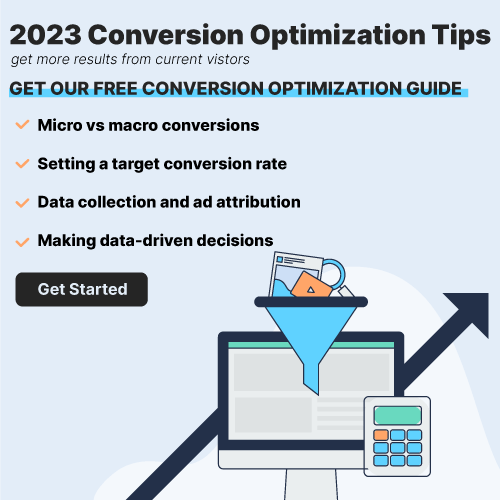Hello, travel enthusiasts! Ready to explore the world’s best tourism websites and plan your next adventure? Our guide to the top 50 tourism websites is here to help.
Our team of digital marketing professionals has scoured the web to find and evaluate the best tourism sites based on design, functionality, uniqueness, and user experience. From visually stunning designs to comprehensive information about travel destinations, these sites embody excellence in the world of tourism.
Not only will you find inspiration for your own travel website, but also gain valuable tips on how to create an online presence that inspires and excites your visitors.
Embark on a virtual journey around the world with the help of this guide, and create an online presence that reflects the beauty and uniqueness of your travel business! You’ll find website examples of travel agencies, accommodation providers, transportation companies, tour operators, and travel technology companies in this list! For examples within other industries, head back to our beautiful website designs article!
Top Tourist Destination Website Designs
1. Travel Oregon
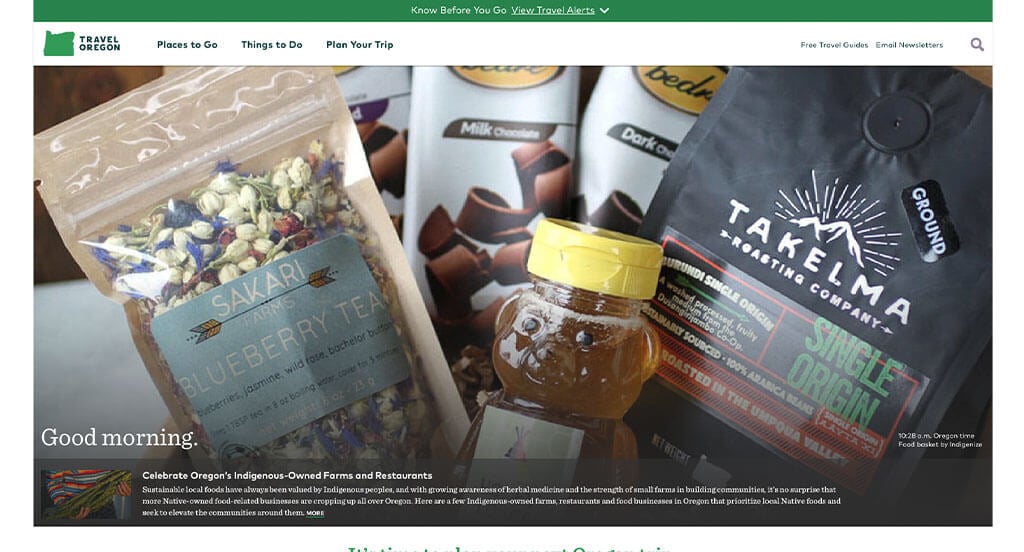
This is a good example of a tourist website design for someone looking for a professional layout. The green accent color was probably the most impactful quality in the homepage of this website. The feature to look at attractions based on an emotion or feeling was another design quality in this professional travel site we enjoyed. Travel Oregon clearly had a focus on internet marketing when designing the fun tree graphics for the bottom of their website. With so many good reasons to consider this tourist destination website, its no wonder we included it in this list of the best websites!
2. Visit Montana
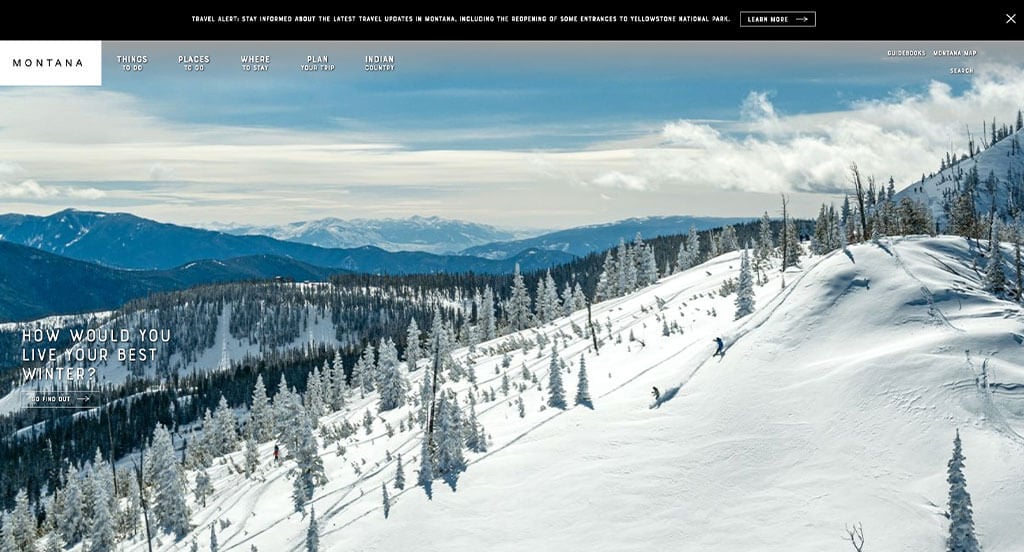
This is a great website example for tourist companies looking for a custom site layout. The high-quality visuals were likely the most impactful quality in the homepage of this website. The integration of social media was definitely refreshing for a custom site. They had website marketing in mind when building the well-labeled navigation bar for their website. Another amazing website to add to this list!
3. Pure Michigan
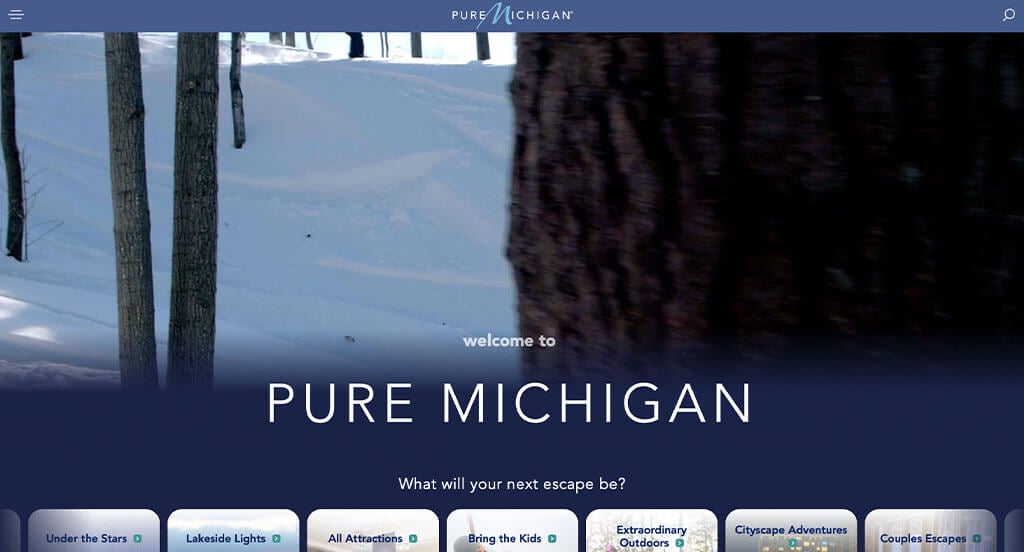
This is a great web design example for tourist destinations to check out when looking for a professional look and feel for their next site. The look and feel of the homepage of this travel website caught our attention because of their calming color scheme. The addition of upcoming events throughout the state was definitely refreshing for a custom tourist site. They had digital marketing in mind when creating the ability to explore by season of the year. For tourist destination owners looking for examples for their next website layout, this design example will absolutely be one to consider.
4. Travel South Dakota
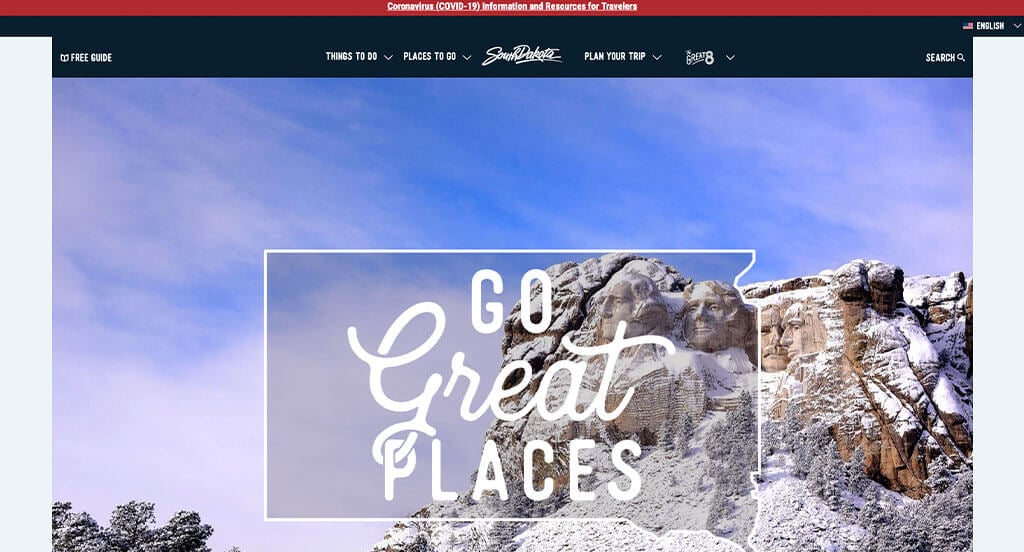
This is a great website design example for tourist companies looking for a custom look and feel. From a design standpoint, we liked the use of typography on this custom tourist website. As you scroll through the homepage of the website, one of the qualities you’ll notice right away is the captivating font. The inclusion of social media was a unique choice for a professional website. Travel South Dakota had ease of use in mind when creating the domain for their website that matches their company’s name. Give some thought to the one-of-a-kind design of this tourist destination website when developing your next custom website.
5. Visit New Mexico
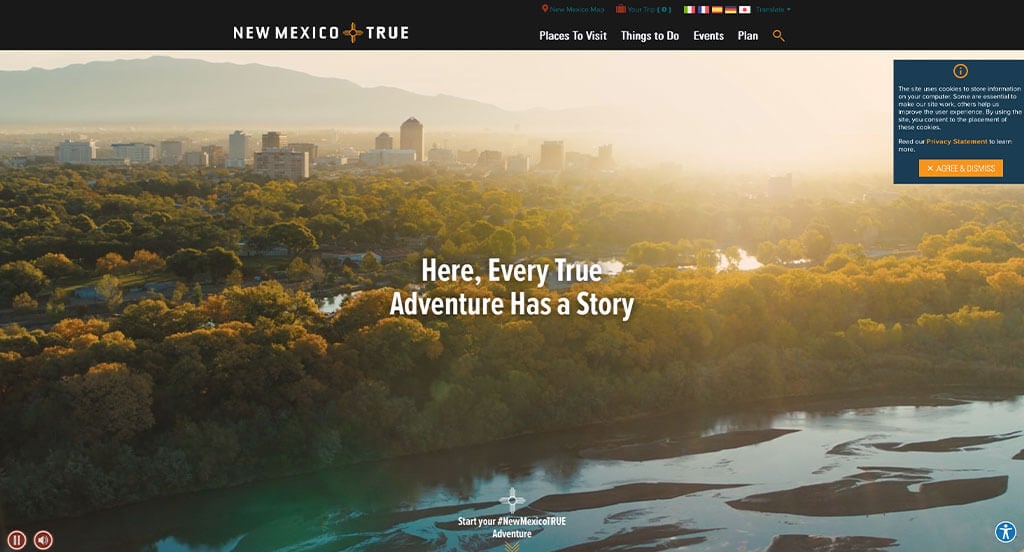
This is a creative website design example for a tourist destination to take a look at when building their next custom website. Our web designers thought this was a good example of a homepage layout for travel companies because of their creative logo design. This professional tourist site also does a good job with their variety of subjects in their imagery. Visit New Mexico clearly had internet marketing in mind when creating the use of a search bar in their website. Be sure to consider the one-of-a-kind design of this travel website when building your next website.
6. Travel Alabama
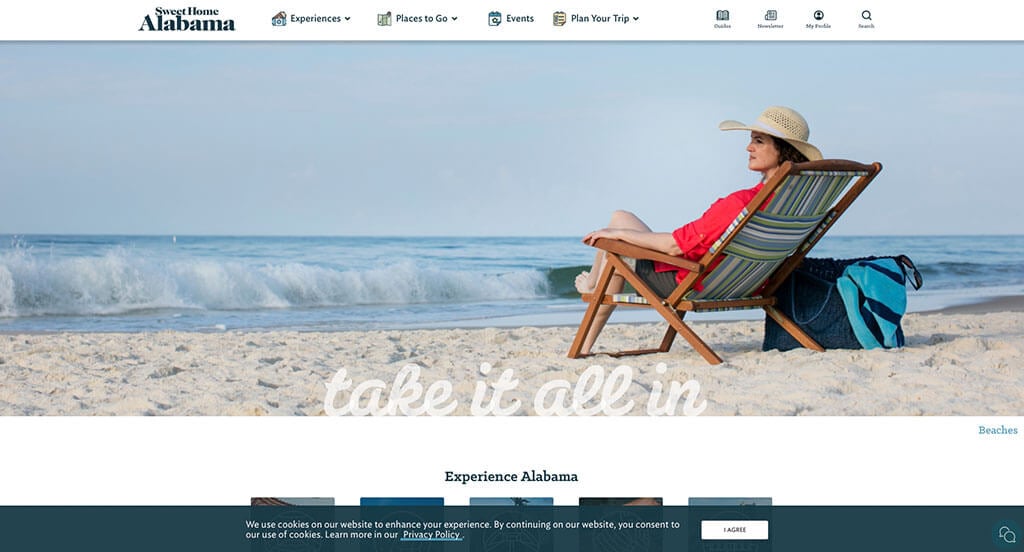
The mainly white, blue and black color palette used in this custom tourist website stood out to us because it creates a feeling that’s authentic to Alabama. The graphics to help users navigate the site was probably the most impactful quality in the homepage of Travel Alabama. Another thoughtful feature in this custom tourist destination website was their relaxing imagery. They clearly had website accessibility in mind when creating the simple navigation for their website. Don’t skip past this website when hunting for design ideas for your next tourist website!
7. Go Hawaii
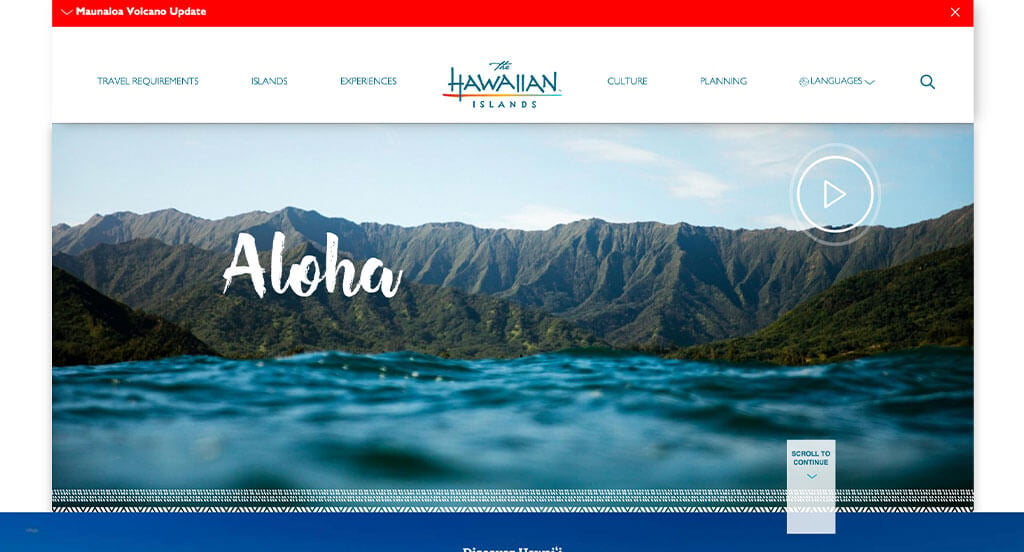
The Go Hawaii website has a very professional feel to it, thanks to its blended use of blue, white and a few other accents. The geometric patterns were definitely the most impactful quality in the homepage of this website. The addition of a map of Hawaii was another unique quality in this professional tourist website we enjoyed. Go Hawaii had website accessibility in mind when creating the clearly labeled menu for their website. What a great website to review when building out your next website!
8. Travel Louisiana
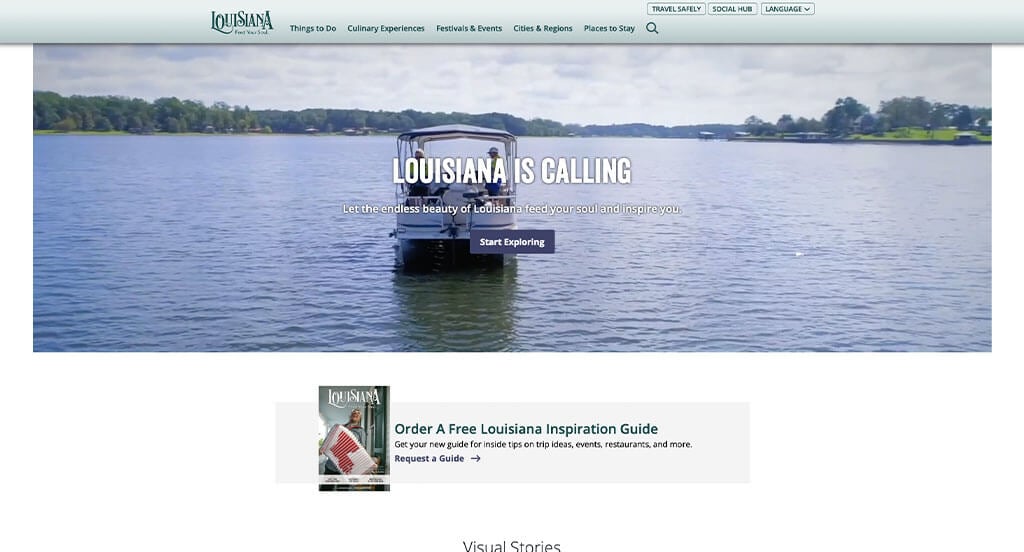
This is a good example of a tourist company website design for a person looking for a professional look and feel. We thought this website was a good design idea for travel because of their automatically playing video. The way they split up Louisiana’s regions was refreshing for a unique tourist website. Travel Louisiana had website usability in mind when designing the navigation bar with organized categories for their website. If you are looking for template ideas for your next tourist site, give some thought to this one.
9. Visit Indiana
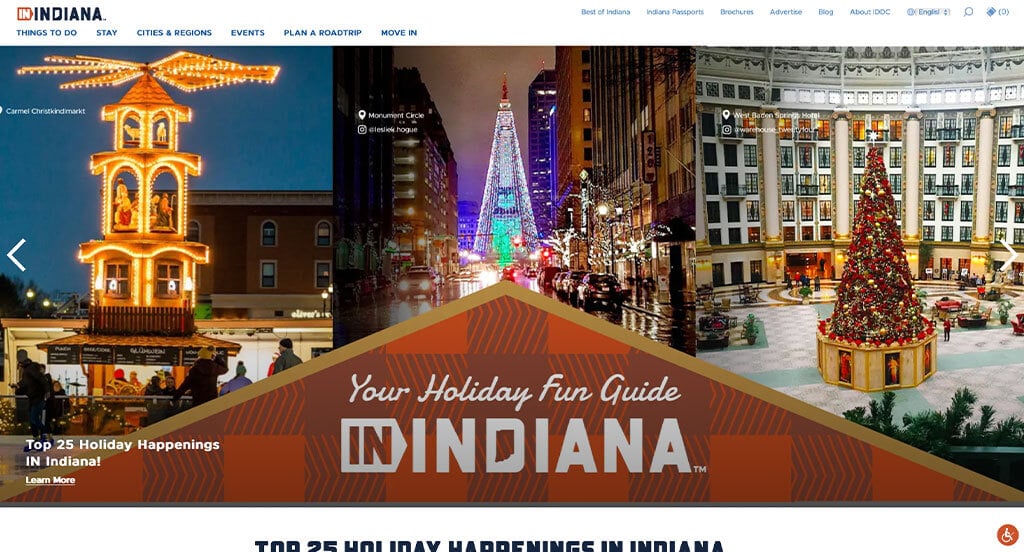
This is a great example for tourist companies who are looking for a professional website layout. Of all the custom travel websites we reviewed, one of the features in this custom website we liked was their optimized content. The addition of a blog was another thoughtful feature in this professional tourist site we enjoyed. They clearly had website accessibility in mind when creating the well organized template for their website. Another amazing website to add to this list!
Related: Tourist destinations often utilize digital marketing as a way of connecting with an engaged audience and nurturing those relationships.
10. Another Escape
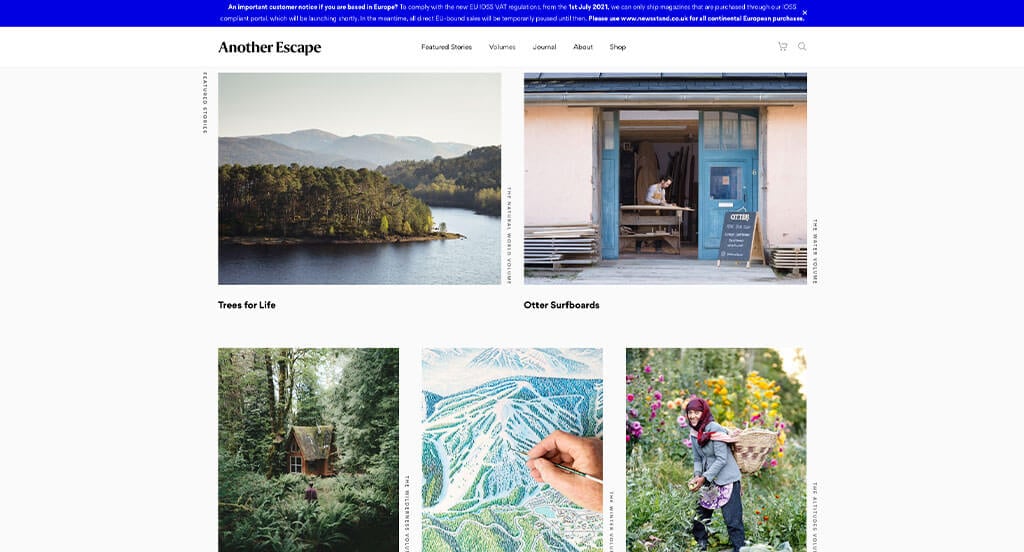
The white, blue, gray and black color palette of this tourist site stood out to us because it creates a simple and striking design. After scrolling past the header of this tourist website, you’ll notice their creative logo design. Another design quality in this clean travel site we liked was their well-labeled navigation bar. Another Escape clearly had a focus on conversions when creating the buttons for simple navigation throughout their website. Any website designer building websites for tourist will want to consider checking this website out.
11. Travel Wisconsin
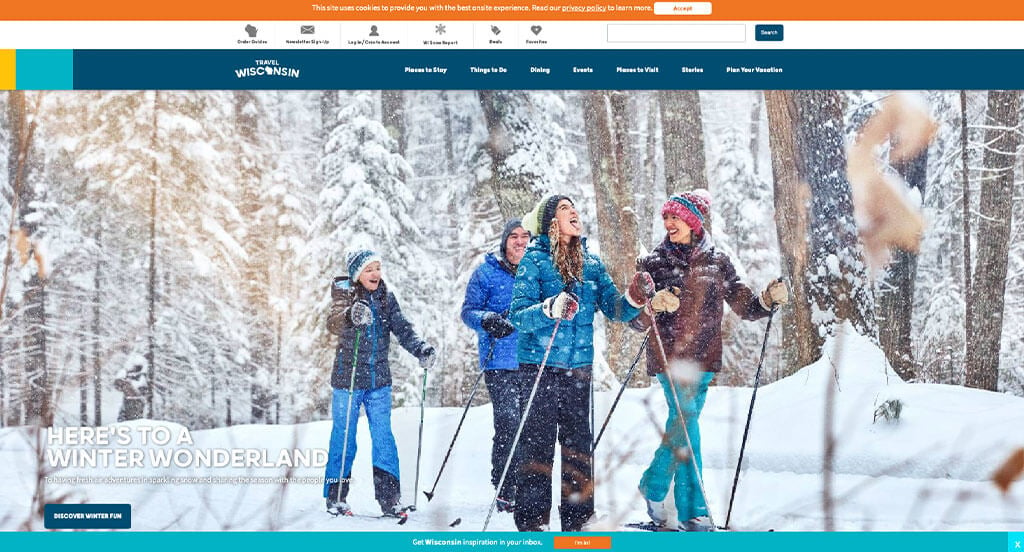
This is a good example of a website design for travel companies who are looking for a professional website layout for their next website. As you scroll through the homepage of this website, one of the design qualities you’ll notice is the ability to look at categories based on the season of the year. The variety of colors used for their pages that blend well together was definitely refreshing for a custom site. Travel Wisconsin had website accessibility in mind when designing the domain for their website that matches their company name. Give some thought to the creative design of this tourist destination website when developing your next custom website.
12. Explore Minnesota
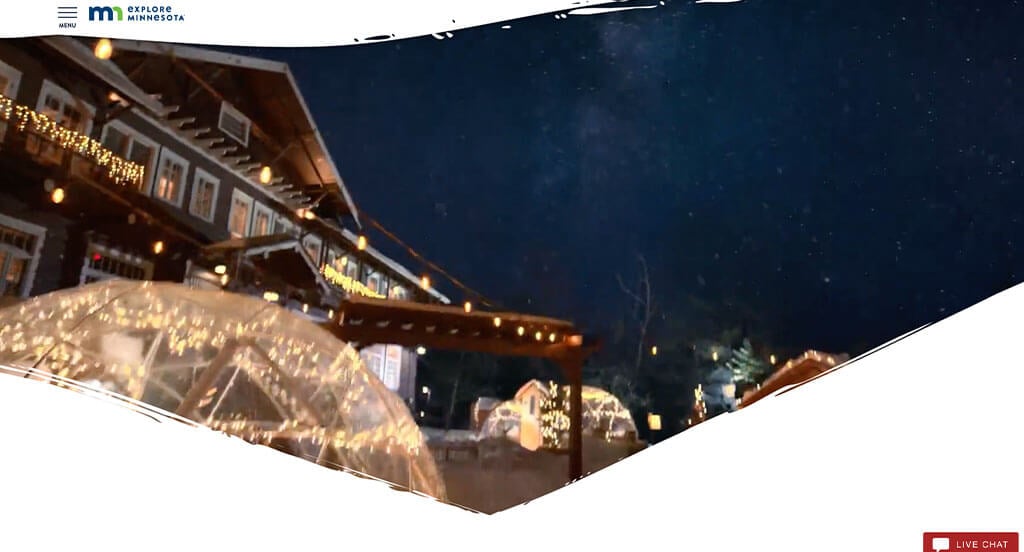
This is a great web design example for tourist companies that are looking for a professional layout for their next custom website. One of the homepage features of Explore Minnesota we noticed was their unique frames for their imagery because that isn’t something you find on most travel websites. This custom travel site also does a good job with their balance of images, text and whitespace. Explore Minnesota clearly had a focus on website marketing when incorporating social media into their website. With so many good reasons to consider this tourist website, it’s obvious why we included it in this list of the best websites!
13. Visit Arizona
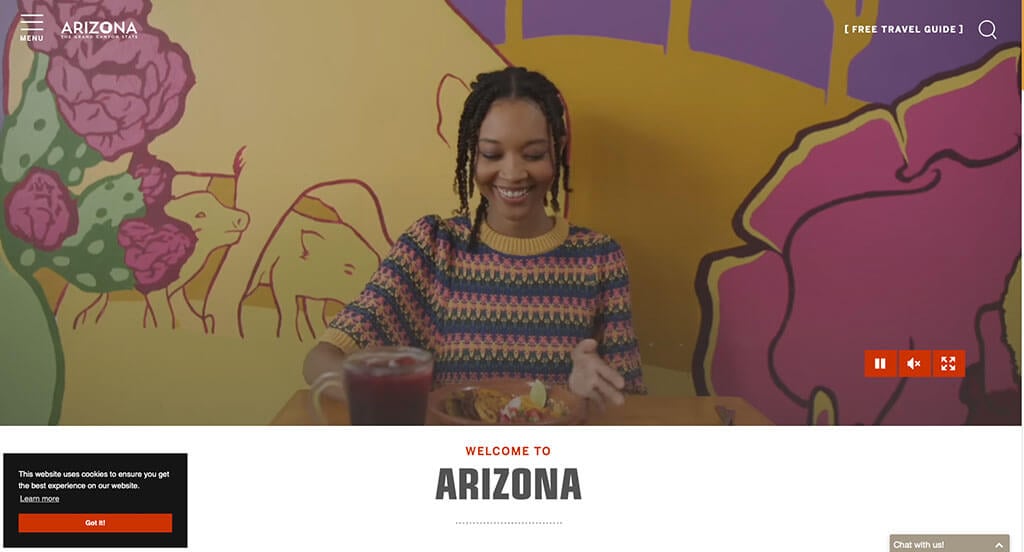
This is a good example of a tourist website design for a person looking for a professional look and feel. The red accent used throughout the page was likely the most impactful feature in the homepage of this website. Another design quality of this creative tourist website we enjoyed was the subtle animations. From a marketing viewpoint, we really liked the way they utilized a clearly labeled menu. Be sure to consider the creative design of this tourist website when developing your next custom website.
14. North Dakota Tourism
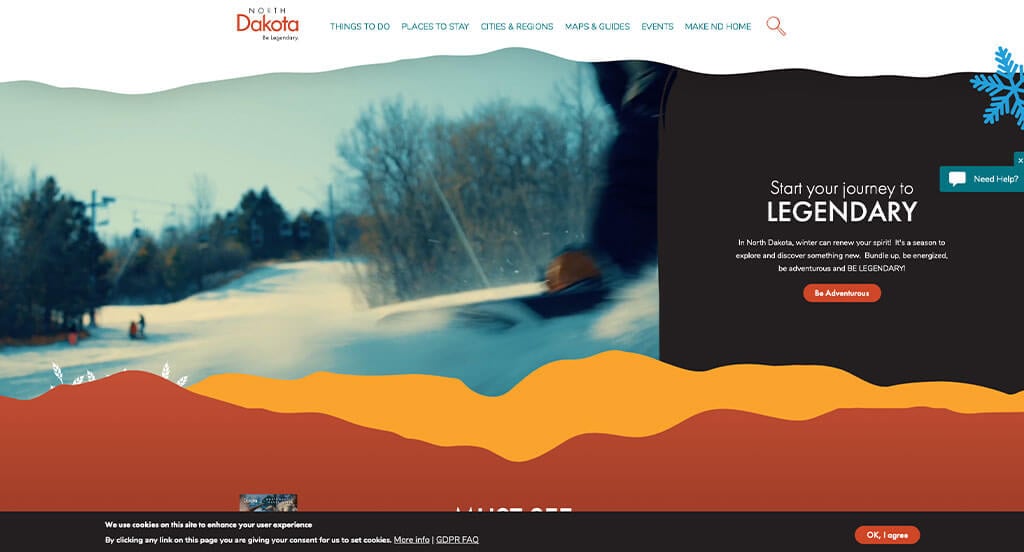
North Dakota Tourism has a well-designed tourist website that uses a combination of both cool and warm colors for a color palette, which we like because it creates a stunning layout. As you scroll through the homepage, one of the qualities you’ll notice right away is the leaf graphics. This clean tourist destination site also does a good job with their layout that inspires nature lovers to visit North Dakota. They had conversions in mind when building the mountain-like color blocks throughout their website. For tourist looking for ideas on their next website, this example will definitely be one to take a look at.
15. Travel Nevada
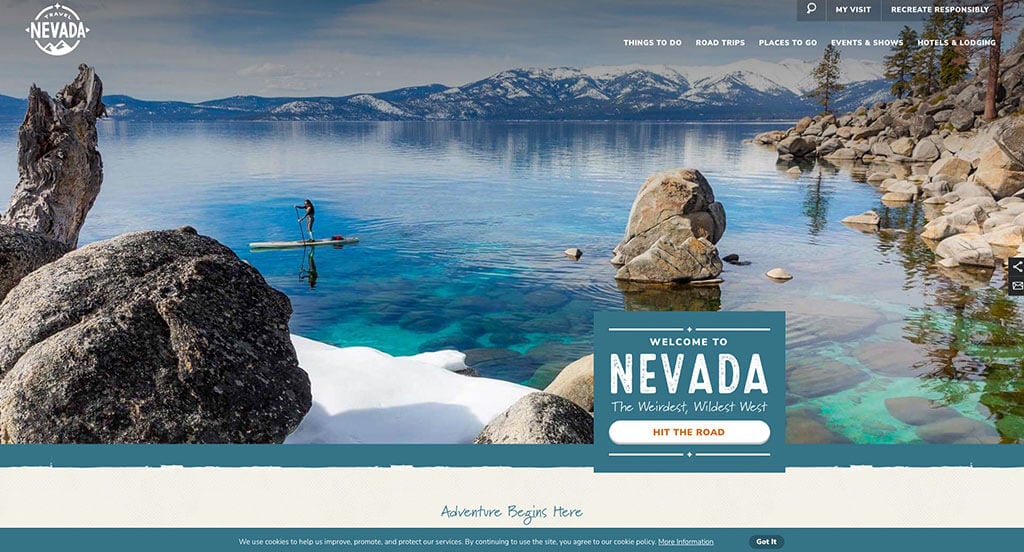
This is a creative website design example for tourist destinations who are looking to build a website. The most refreshing part of this tourist website was the stunning logo design. The different sized fonts to help titles stand out was another reason why we included this website in our list of the best website layouts for tourist destinations. They had ease of use in mind when designing the simple layout for their website. What a great website to review when designing your next website!
16. Travel Oklahoma
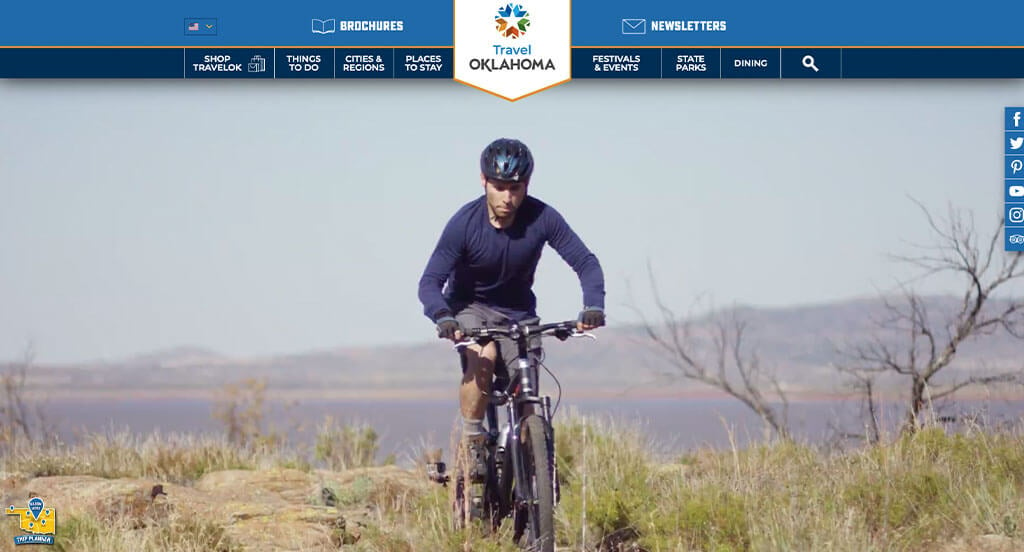
Our team liked the black, white, yellow and blue color scheme used in the Travel Oklahoma website, because they look great with each other. The creative graphics used for the background was likely the most impactful feature in the homepage of Travel Oklahoma. Another feature in this custom tourism website was their alluring imagery. Travel Oklahoma clearly had ease of use in mind when building the navigation bar with organized categories for their website. There was no shortage of reasons to include this website in our list of websites for tourist companies to consider when developing their next website.
17. Visit Idaho
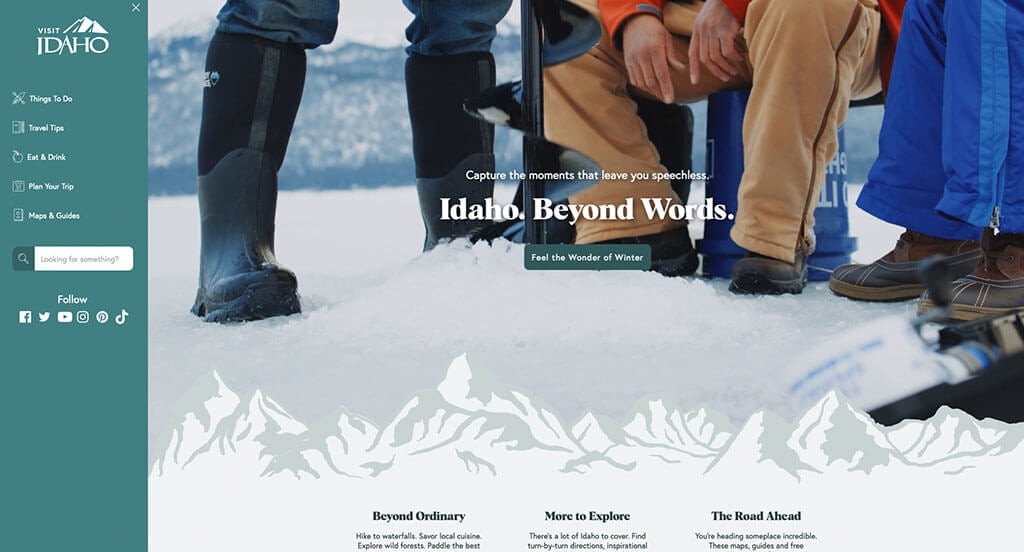
This is a great website design example for tourism groups who are looking for a custom website. The layout of this travel website was thoughtful because of the monochromatic color scheme. This clean tourist site also does a good job with their mountain graphics. They clearly had website usability in mind when designing the buttons for simple navigation throughout their website. So many attractive qualities to consider when ranking this website.
18. Visit Missouri
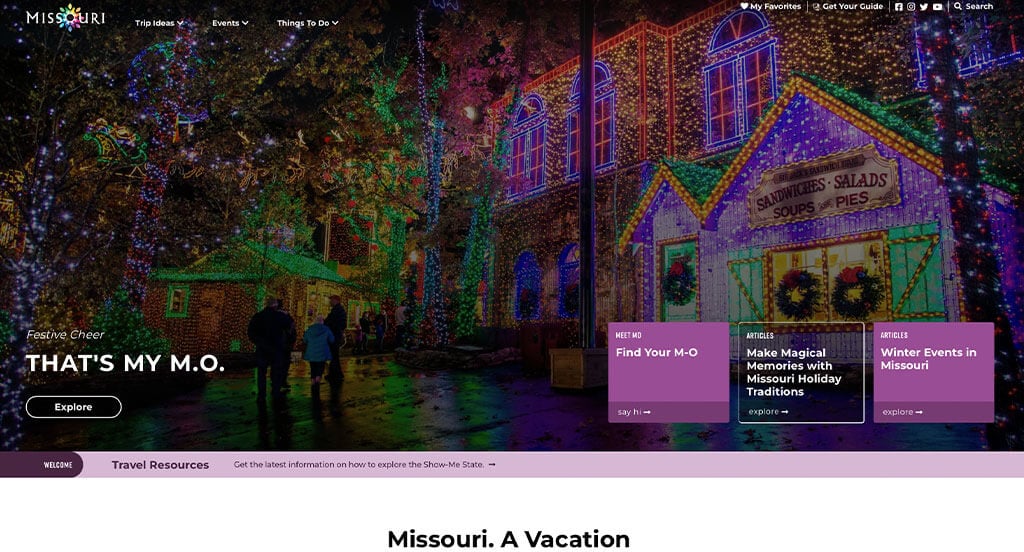
The Visit Missouri website has a very professional feel to it, thanks to its unique use of lots of accent colors. The unique quiz to help viewers plan related to their likes was likely the most impactful feature in the homepage of Visit Missouri. The high-quality visuals were refreshing for a custom site. From a marketing perspective, we really liked the way they utilized an assortment of information. These were just a few of the numerous qualities in this website we had to consider while putting together this list of top websites for tourism.
19. Vermont Vacation
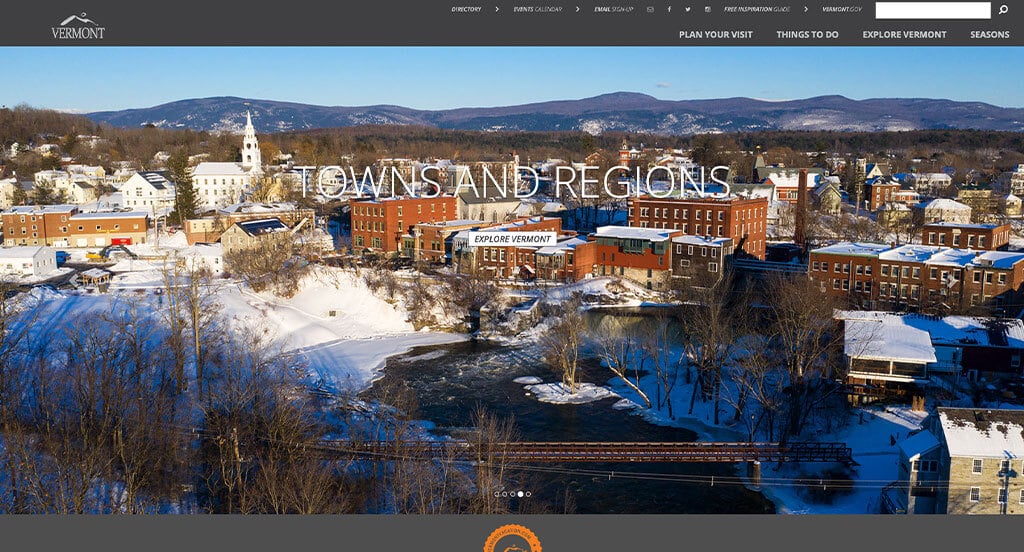
For a tourism website, they did a great job utilizing the gray, orange, white and black colors throughout their site. Our web designers thought this website was a good example for travel because of their organization of information. The large imagery was a nice touch for a unique website. They clearly had internet marketing in mind when building the domain for their website that matches their company name. If you are looking for template options for your next tourist website, be sure to check this one out.
20. Visit Finland
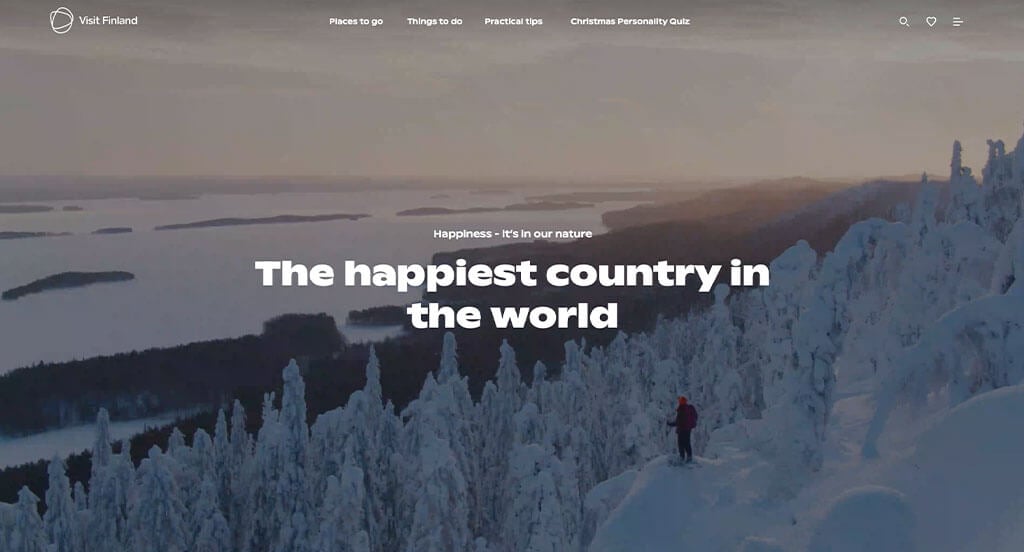
This is a creative website design example for a tourist destination looking to build their next website. The captivating font was probably the most impactful quality in the homepage of this website. The frequently asked questions area was refreshing for a unique tourism website. Visit Finland clearly had a focus on ease of use when designing the simple navigation throughout their website. Be sure to consider the one-of-a-kind design of this tourist website when developing your next website.
21. I Love New York
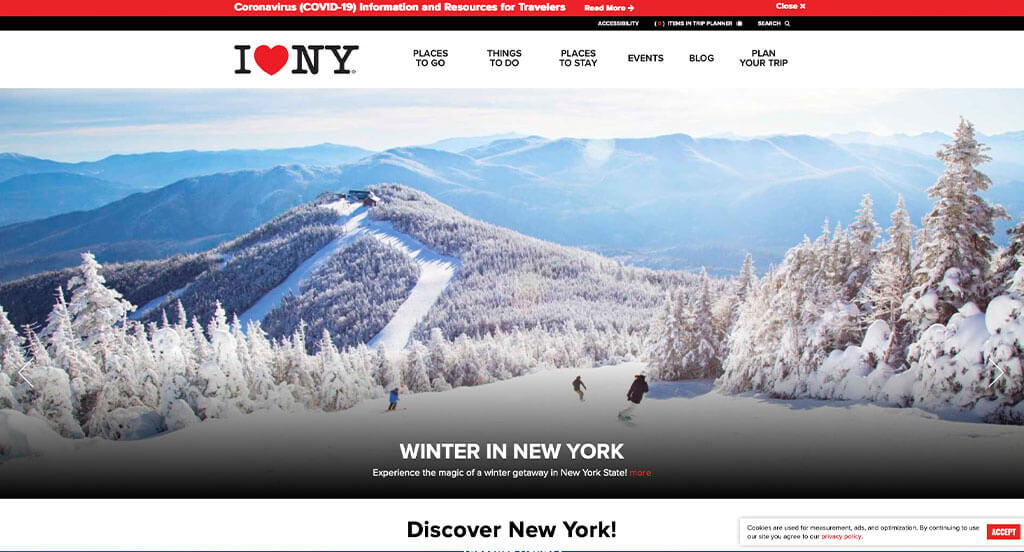
The I Love New York website has a very classy feel to it, thanks to its blended use of white, red, black and gray. After scrolling past the navigation of this travel site, you’ll immediately notice the large and memorable logo design. The addition of a blog was refreshing for a custom website. They clearly had a focus on digital marketing when creating the well-labeled navigation bar for their website. You won’t be disappointed after reviewing this website for design ideas for your next website!
22. Visit Washington
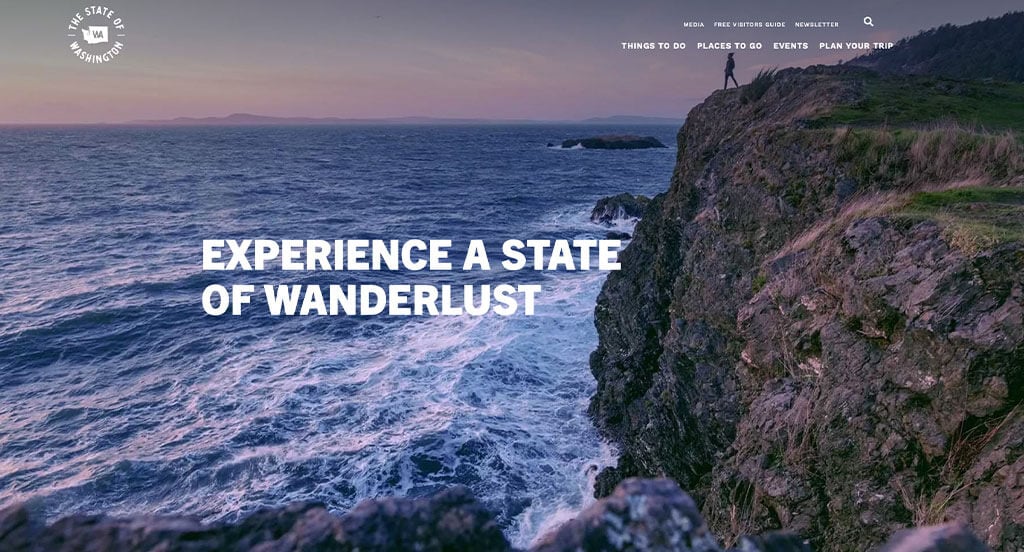
This is a good example of a website design for tourist destination looking for a professional look and feel for their next website. The breakup of their regions and popular destinations within the region was definitely the most impactful feature in the homepage of Visit Washington. The incorporation of social media was another design quality in this professional tourist website we enjoyed. Their addition of a search bar helped make this one of the best tourism websites we reviewed. For the tourist destinations out there looking through website examples, make sure to check this one out!
23. Texas Vacation

Texas Vacation has a well-designed tourist website that uses a blue and white color palette, which we liked because it catches the eyes of viewers. After scrolling past the header of this tourist website, you’ll notice the automatically playing video as the background. The high-quality visuals were another reason why we included this website in our list of the best website layouts for travel destinations. They clearly had conversions in mind when building the optimized content for their website. Give some thought to the creative design of this tourist website when building your next website.
24. Travel Iowa
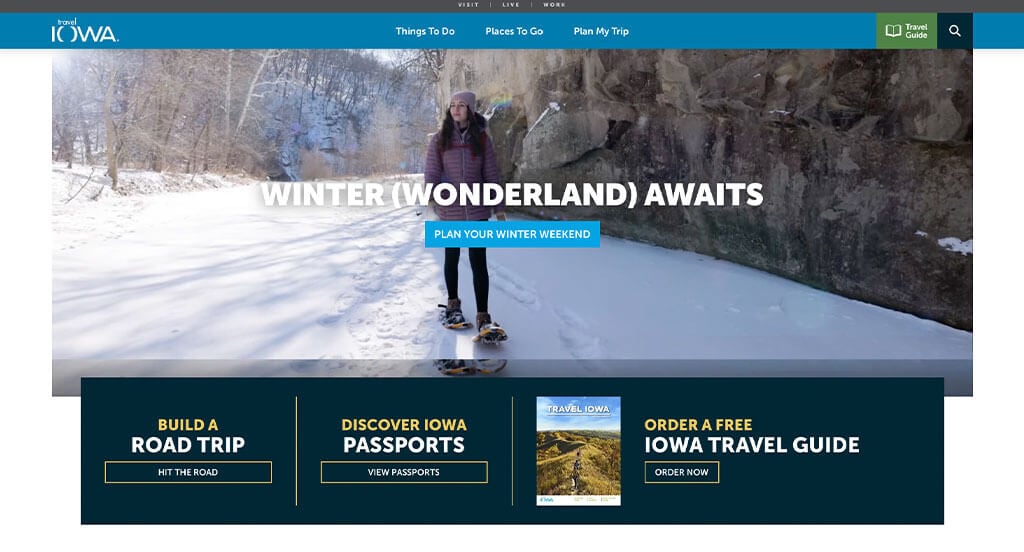
This is a good example of a travel destination website design that can give inspiration to other companies for their professional website. One of the design features we liked most in the homepage of Travel Iowa was the buttons to enhance usability. The incorporation of social media was a unique choice for a custom website. Travel Iowa had conversions in mind when designing the navigation bar for their site with organized categories. There was no shortage of reasons to include this website in our list of websites for tourist destinations to consider when designing their next website.
Related: Rank your vacation hotspot in search results with the help of a local SEO agency with experience in the industry.
25. Visit Rhode Island
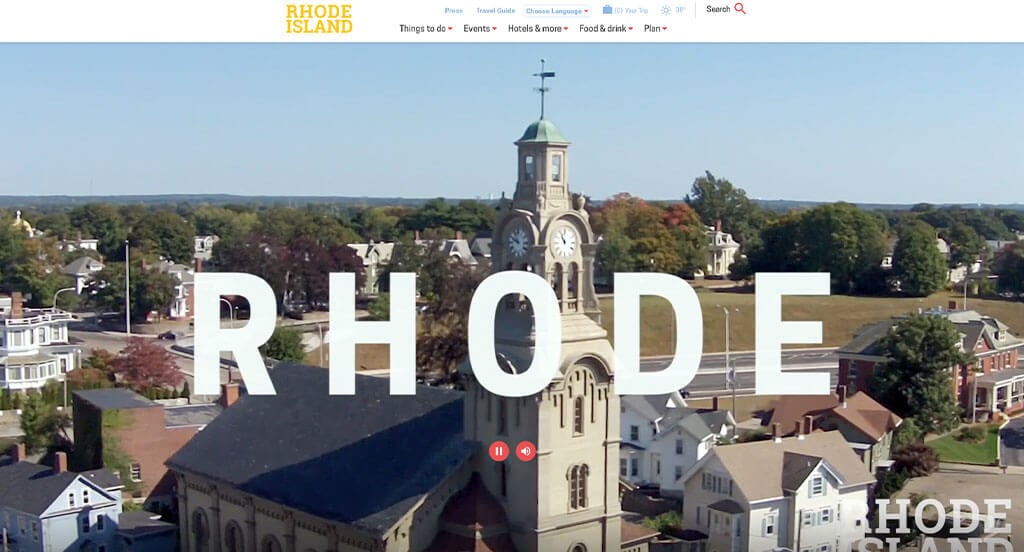
The Visit Rhode Island website has a very professional feel to it, thanks to its unique use of white, blue, yellow and red. We thought this was a good example of a homepage layout for travel destinations because of their creative search bar animation that viewers notice right away. Another thoughtful feature in this professional travel site we liked was the addition of a blog. Visit Rhode Island clearly had conversions in mind when designing the domain for their website that matches the company name. What a great website to review when designing your next travel website!
26. Visit North Carolina
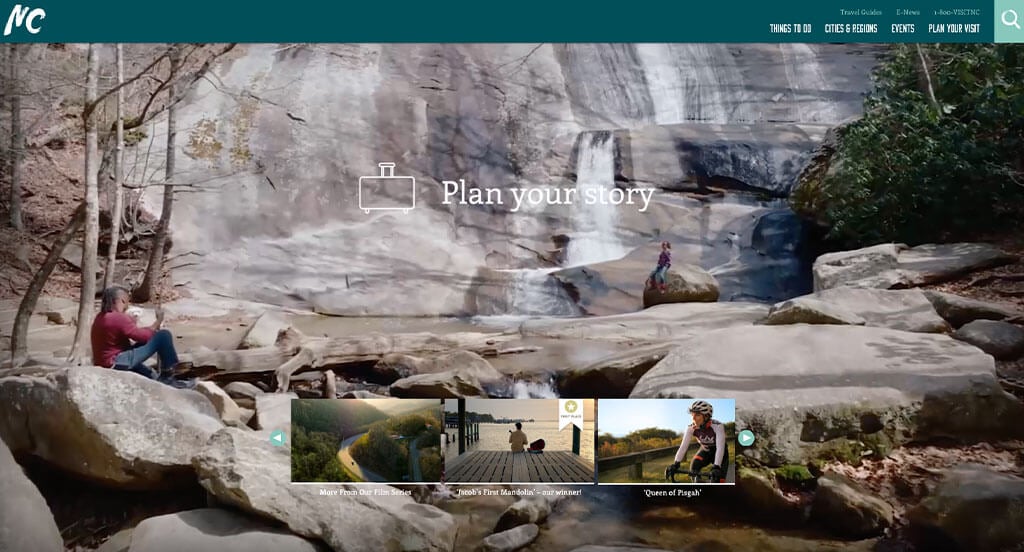
We immediately noticed the teal, blue and white color scheme used in the Visit North Carolina website, which we liked because it creates a relaxing feel. As you scroll through the homepage of the website, one of the qualities you’ll notice right away is the patterned graphics used as a background. Another feature in this clean travel site we liked was the stunning imagery in their social media section. Visit North Carolina clearly had digital marketing in mind when designing the template that was easy to navigate. Be sure to consider the creative design of this travel destination website when building out your next website.
27. Visit Utah
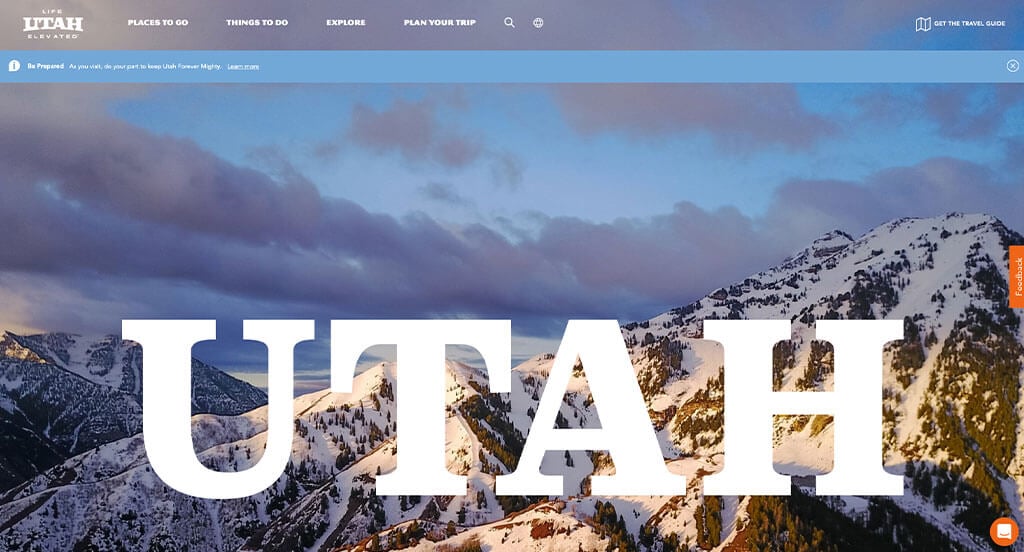
This is a great website design example for tourist destinations looking for a custom website idea. One of the design features we liked most on the homepage of Visit Utah was the stunning monochromatic color scheme because it was rather refreshing for a tourist website. Another thoughtful quality in this custom travel destination website was the clearly labeled menu. The inclusion of a search bar helped make this one of the best travel websites we considered. Talk about a great website to have included in this list of top websites!
28. Enjoy Illinois
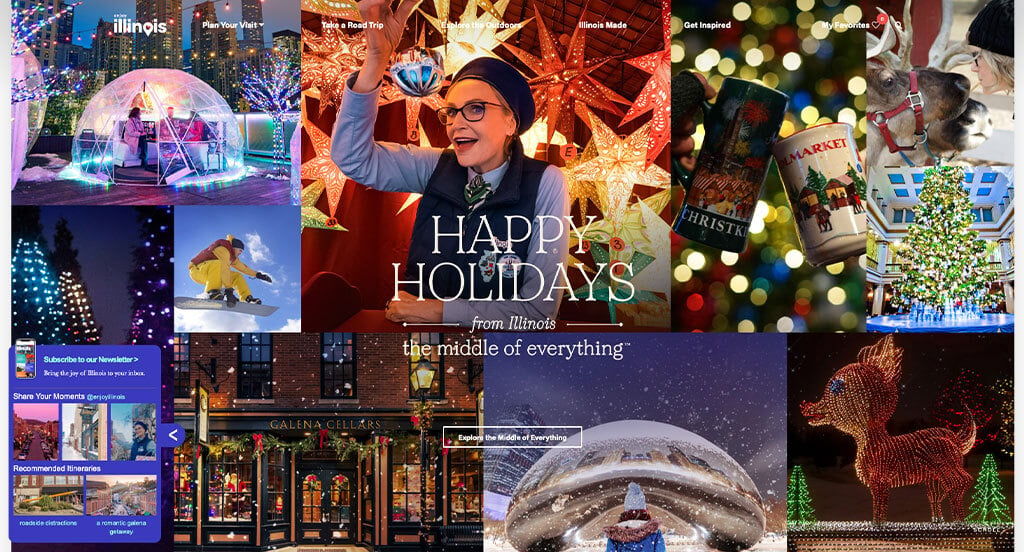
This is a creative website design example for tourist companies to check out when looking to build their next professional website. One of the homepage features of Enjoy Illinois we noticed was their graphics to help organize their categories. Their reoccurring logo was refreshing for a unique tourist destination site. Visit Illinois had digital marketing in mind when creating the simple navigation throughout their website. If you are looking for template ideas for your next travel website, be sure to check this one out.
29. Visit Pennsylvania
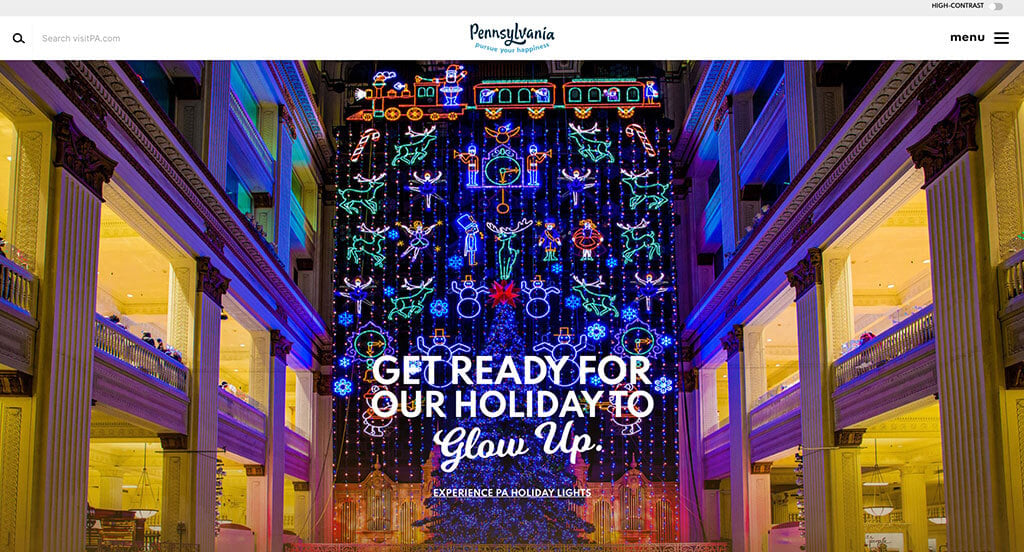
This is a creative website design example for a tourist destination looking to build their next custom website. The captivating layout was probably the most impactful quality of the homepage of Visit Pennsylvania. Another thoughtful quality in this custom tourist site was the basic but pleasing logo design. Their incorporation of videos helped make this one of the top travel websites we looked at. With so many good reasons to consider this tourist destination website, it’s obvious why we included it in this list of the best websites!
30. Visit Brasil
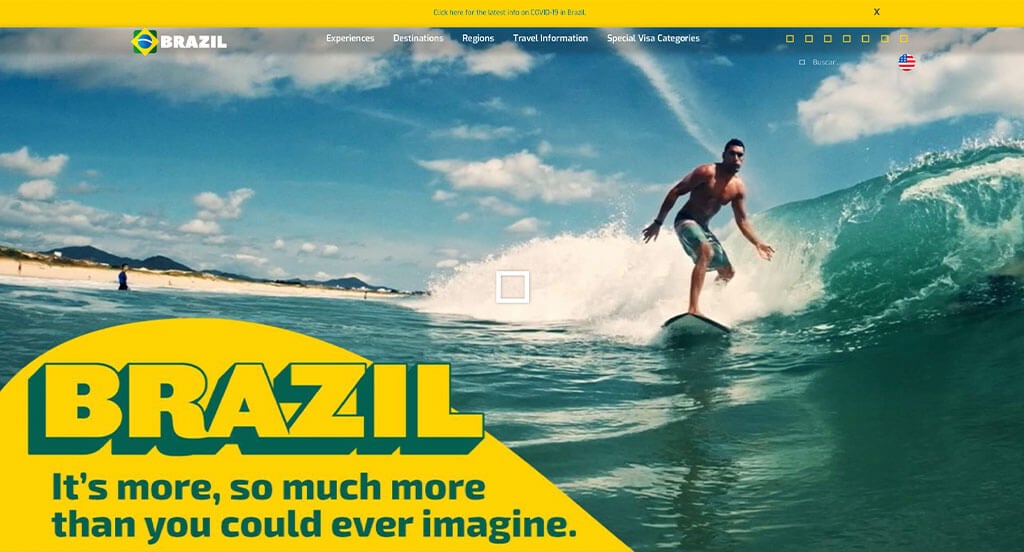
The website of Visit Brasil ranked because it’s one of the nicer tourism websites we have encountered. After scrolling past the header of this tourist website, you’ll immediately notice the colorful and unique logo design. This custom travel site also does a good job with their incorporation of social media. Visit Brasil clearly had a focus on conversions when designing the stunning color palette used in their website. Don’t forget to check this website out while looking through our list of the best tourist sites!
31. Visit California
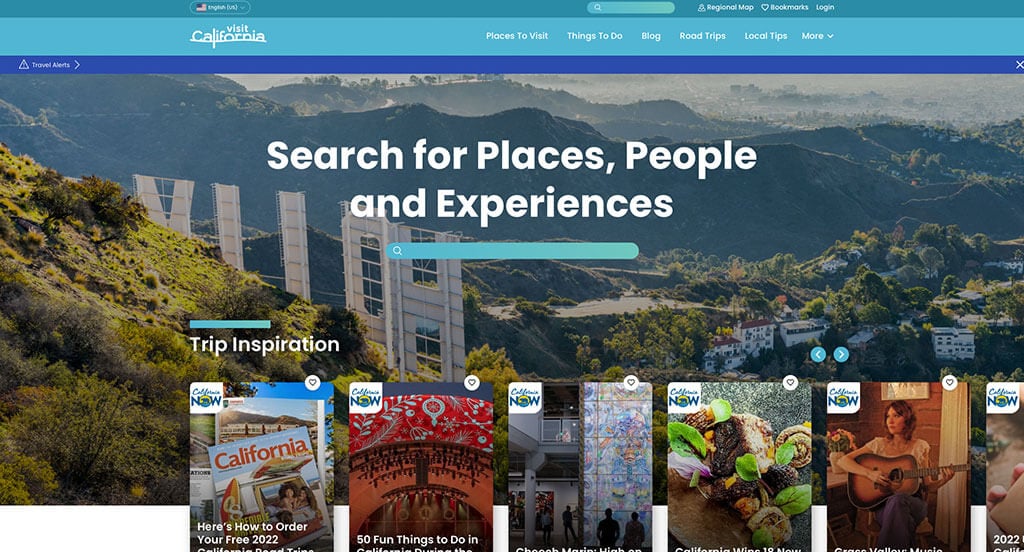
Visit California has a great looking website that uses white, yellow, orange and blue for a color scheme, which we like because it reminds viewers of the stunning beaches and the sun in California. The organized categories on their page was likely the most impactful quality in the homepage of this website. Another thoughtful quality in this professional travel website we enjoyed was the stories included into the site. They clearly had website marketing in mind when designing the high-quality imagery in the social media area of their website. Give some thought to the one-of-a-kind design of this tourism website when developing your next custom website.
32. Visit Arkansas
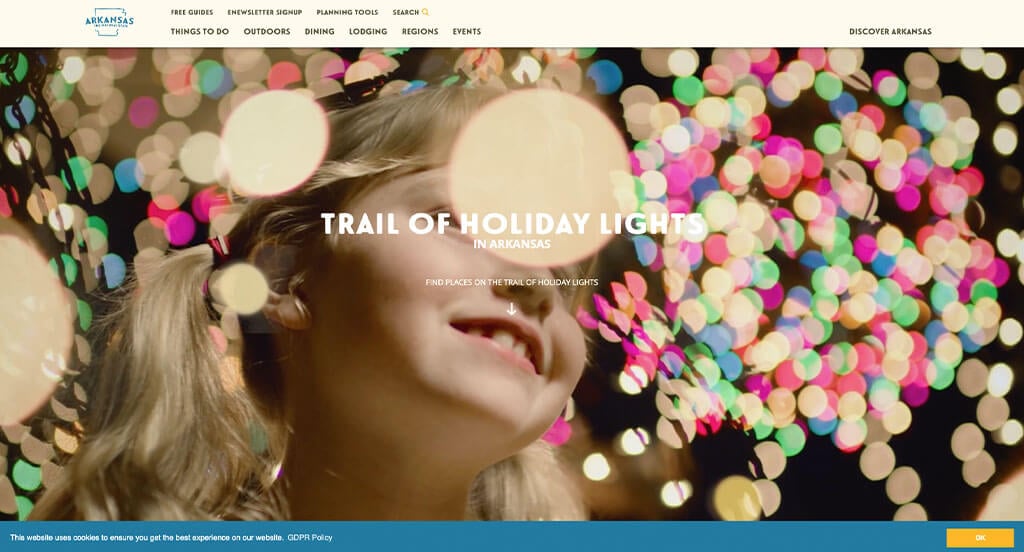
The white, cream, blue and yellow colors used in this tourism website stood out to us because it was simple but still professional looking. The captivating font was likely the most impactful quality in the homepage of this website. The use of maps of the state was absolutely a consideration when ranking Visit Arkansas in this list of top tourism websites. They clearly had website marketing in mind when building the well-labeled navigation bar for their website. For the tourist destinations out there searching for website examples, make sure to check this one out!
33. Visit Florida
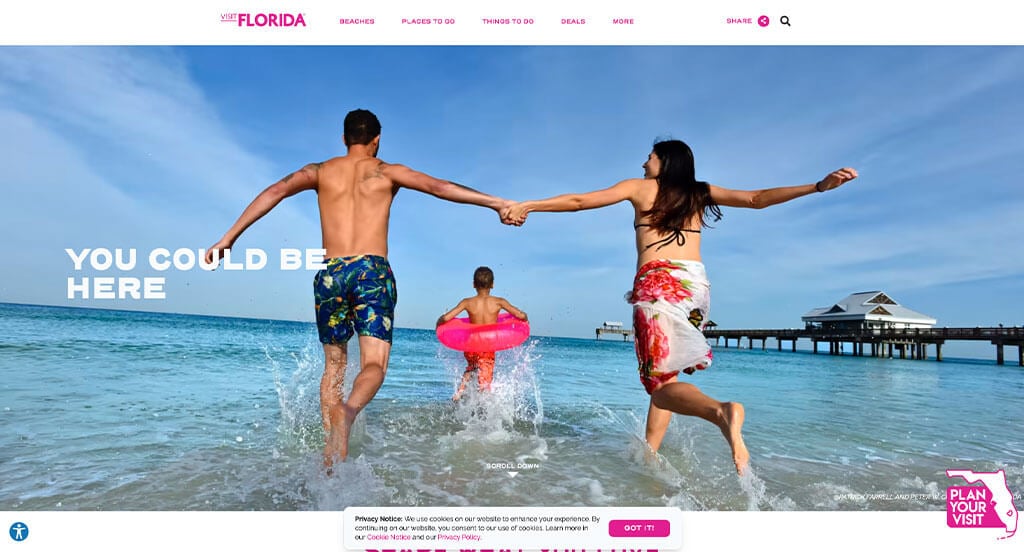
This is a great website design example for tourist destinations looking for custom website layout ideas. As you scroll through the homepage of the website, one of the design qualities we liked was their captivating visuals. The pink accent was a unique choice for a custom travel website. They clearly had conversions in mind when creating the integration of social media. Be sure to consider the unique design of this tourism website when building out your next website.
34. Tennessee Vacation
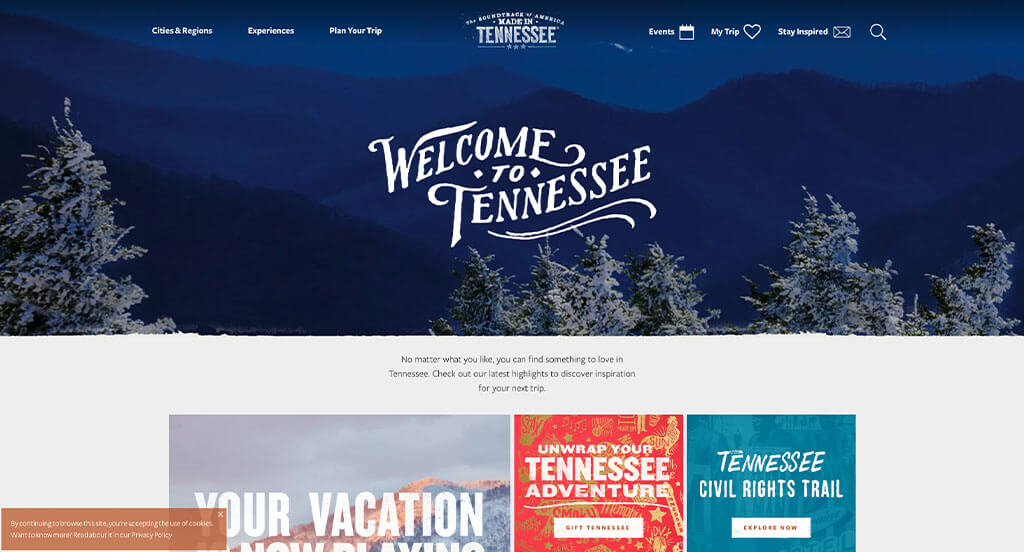
This is a good example of a website design for tourism areas looking for a professional look and feel for their next custom site. The professional font was definitely the most impactful quality in the homepage of this website. Another thoughtful quality in this creative tourism website was the creative graphics. Tennessee Vacation had website accessibility in mind when building the well-labeled navigation bar for their website. These were just a few of the numerous qualities in this website we had to consider while we were putting together this list of top websites for travel.
35. Colorado Tourism
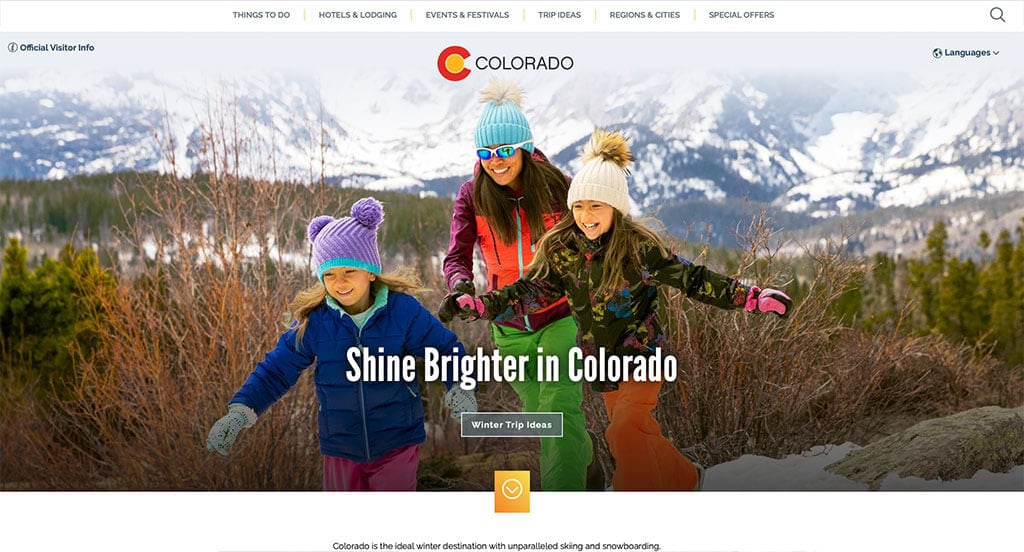
There were numerous travel destination sites to choose from, but the website for Colorado Tourism was the perfect example of a well-designed website that used white with multiple different accent colors for their color scheme. Of all the custom travel websites we reviewed, one of the features in this custom website we liked was the logo that relates to the state. Another feature in this custom travel destination site we liked was their framing for some of the images and text. Colorado Tourism clearly had a focus on ease of use when creating the categories so viewers can look at events they would be interested in. Give some thought to the great design of this tourism website when building out your next website.
36. Discover South Carolina
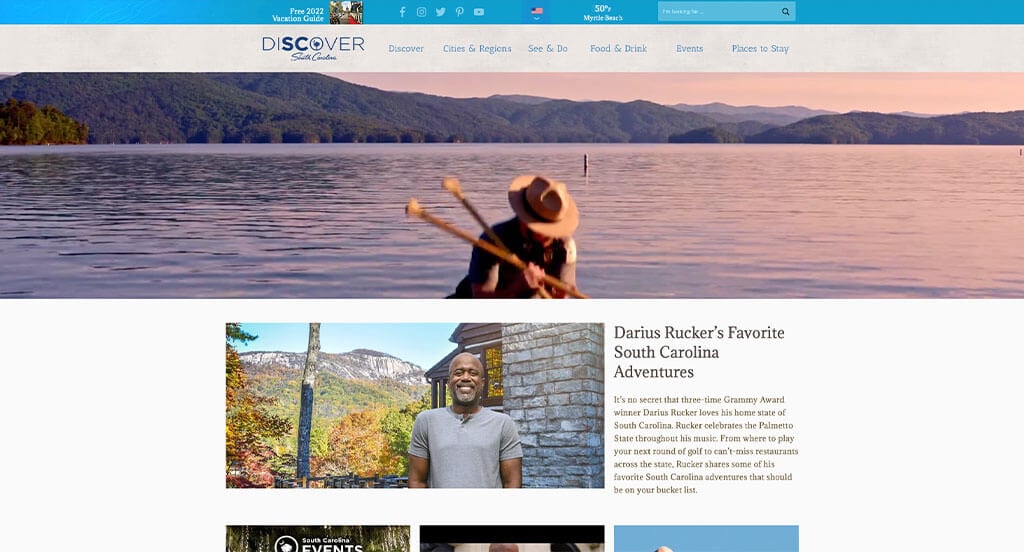
The white, blue, brown and black color palette used in this tourism website stood out to us because it looks relaxing. The videos and information based on Darius Rucker’s favorite places to visit was likely the most impactful quality in the homepage of Discover South Carolina. Another thoughtful feature in this clean tourism site we noticed was their thought provoking logo design. From a marketing point of view, we really liked the way this travel destination website utilized icons to help users navigate their website. Any website designer making websites for tourist companies will want to consider checking this website out.
37. Visit Nebraska
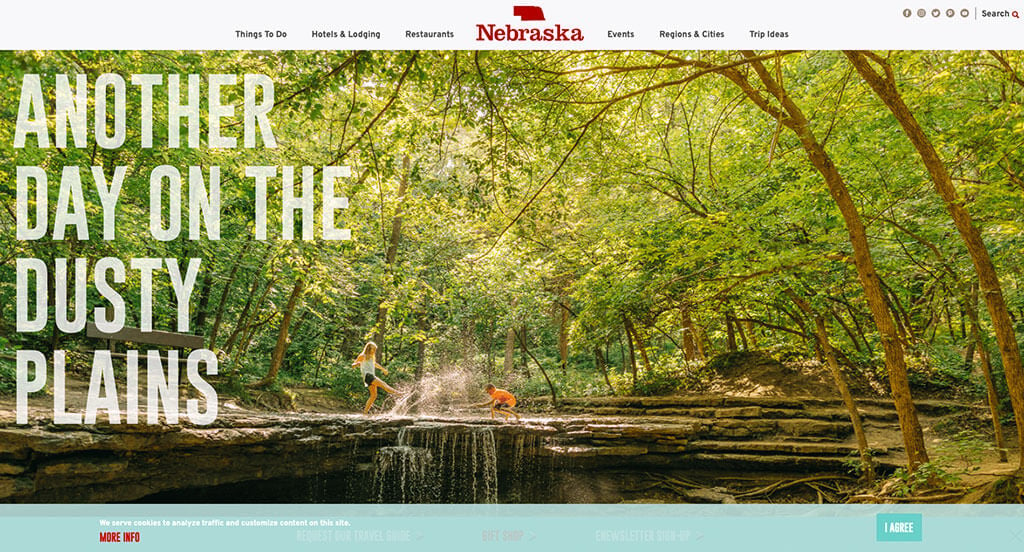
This is a great web design example for travel destinations looking for a professional layout idea. The most refreshing part of this travel website was their images that truly represent the heart of Nebraska. The different sized fonts to emphasize titles was refreshing for a custom tourist website. Visit Nebraska clearly had a focus on digital marketing when creating the domain for their website that matches their company’s name. Talk about a great website to have included in this list of top websites!
Related: When SEO isn’t getting the results you need fast enough, look toward paid advertising for instant awareness for your vacation or tourist destination.
38. Kentucky Tourism
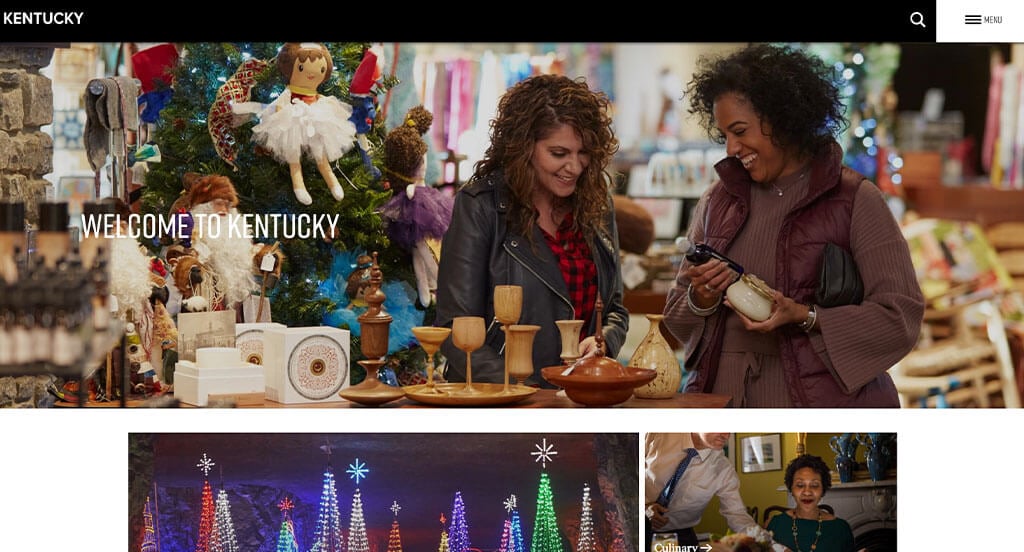
This is a good example of a website design for tourism destinations looking for a custom look and feel for their next site. The addition of a map laying out all the towns was likely the most impactful quality in the homepage of Kentucky Tourism. Another design quality in this custom travel site was how they showed popular categories within each region of the state. From a marketing perspective, for a tourism website we really liked the way they utilized a search bar that allows for filters. You won’t be disappointed after reviewing this website for design ideas for your next website!
39. Visit New Jersey
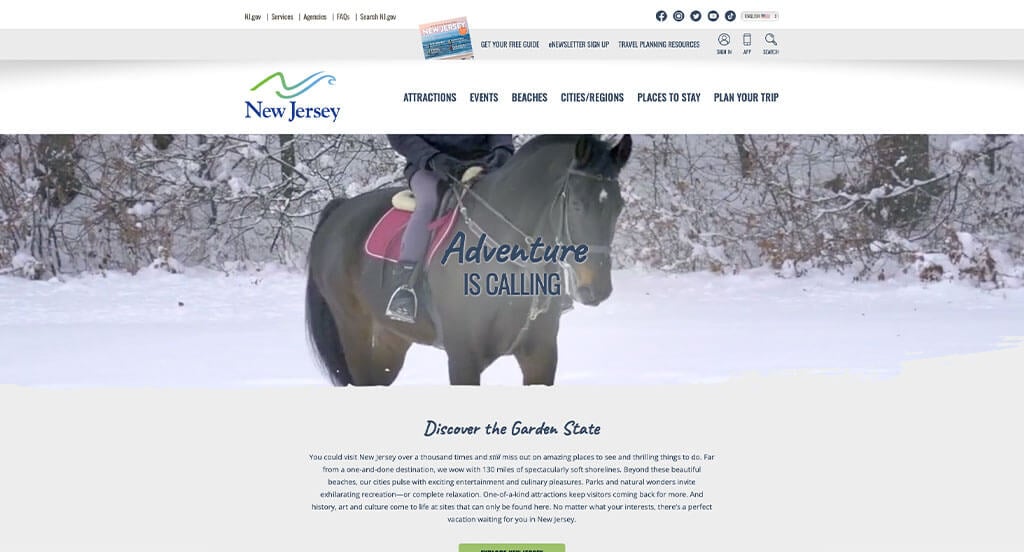
This is a great web design example for tourism destinations looking for a professional layout for their next site. We thought this was a good homepage design example for tourist areas because of their simple but stunning logo design. Another thoughtful feature in this custom travel destination site was the captivating font. Visit New Jersey clearly had a focus on website marketing when building the striking layout for their website. If you are looking for template ideas for your next tourism website, be sure to check this one out.
40. On The Grid
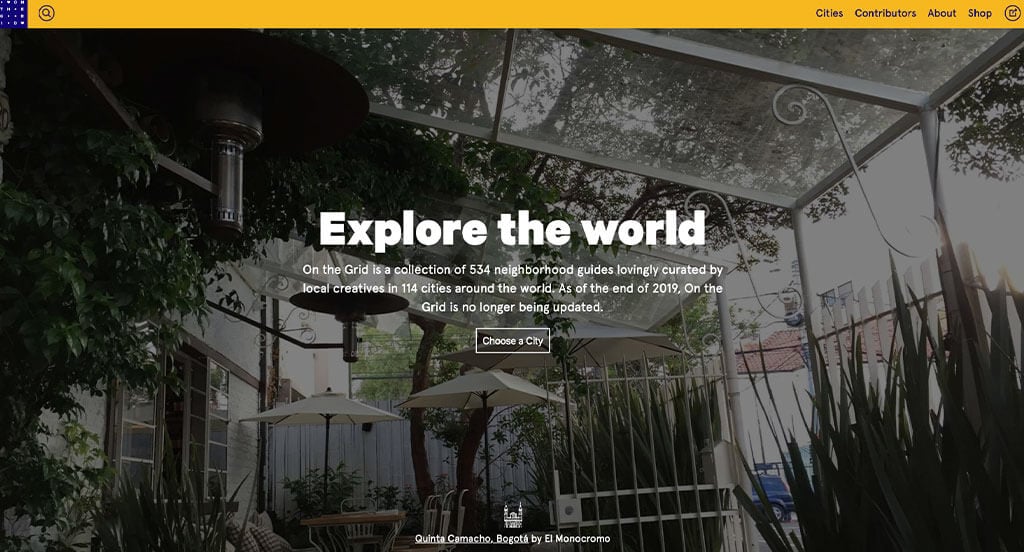
The bright color palette used in this custom tourism website stood out to us because it creates an energetic environment. One of the design features we liked most in the homepage of On The Grid was their focus on different areas in different states because it was rather refreshing for a tourism website. Another feature in this creative travel destination website we noticed was their graphics showing landmarks from different areas. They clearly had website marketing in mind when building the captivating logo design for their website. Be sure to consider the great design of this tourist website when developing your next custom website.
41. Discover Los Angeles
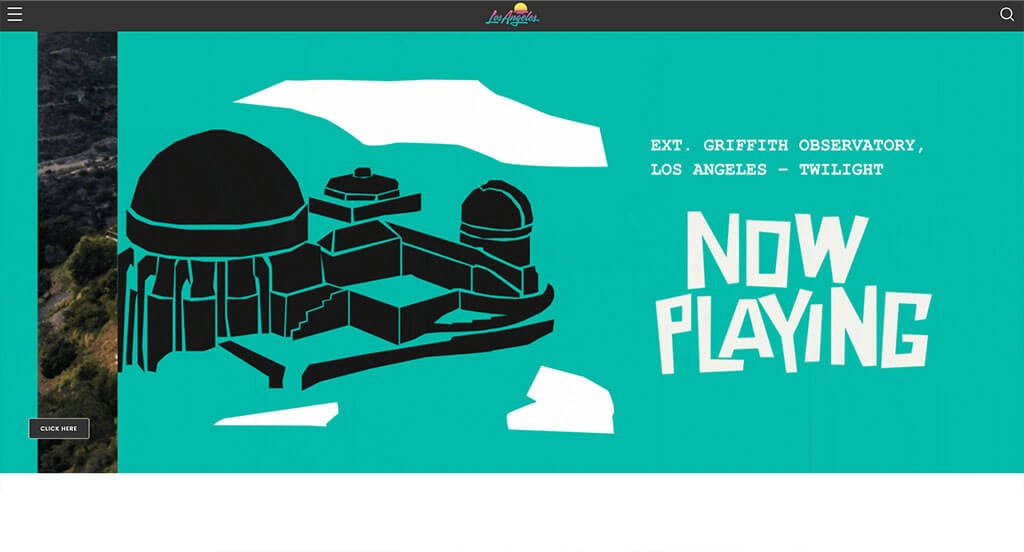
This is a good example of a website design for tourism destinations who are looking for a custom site design. As you scroll through the homepage of the website, one of the design qualities you’ll see is the graphic portraying a silhouette of palm trees for a background. Another thoughtful quality in this custom tourism site was the layout that used up every area of the page and still looked great. Discover Los Angeles clearly had a focus on website marketing when creating the exciting logo design for their company. With so many quality reasons to consider this travel website, it’s obvious why we included it in this list of the best sites!
42. Visit Mississippi
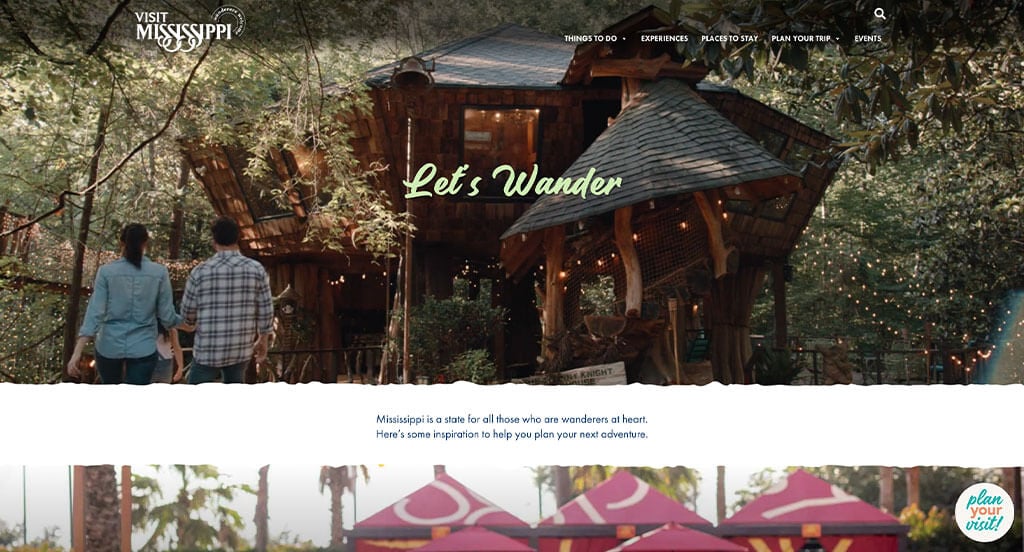
The Visit Mississippi website has a very classy feel to it, thanks to its unique use of white, cream, blue, green. As you scroll through the homepage of the website, one of the design qualities we liked was the variety of ways to break up content. Another thoughtful quality in this professional travel site was the display of things to do with a picture of the state to show where it’s located. They clearly had conversions in mind when creating the tourism destination in their website. Don’t scroll past this website when hunting for design ideas for your next travel website!
43. Visit Wyoming
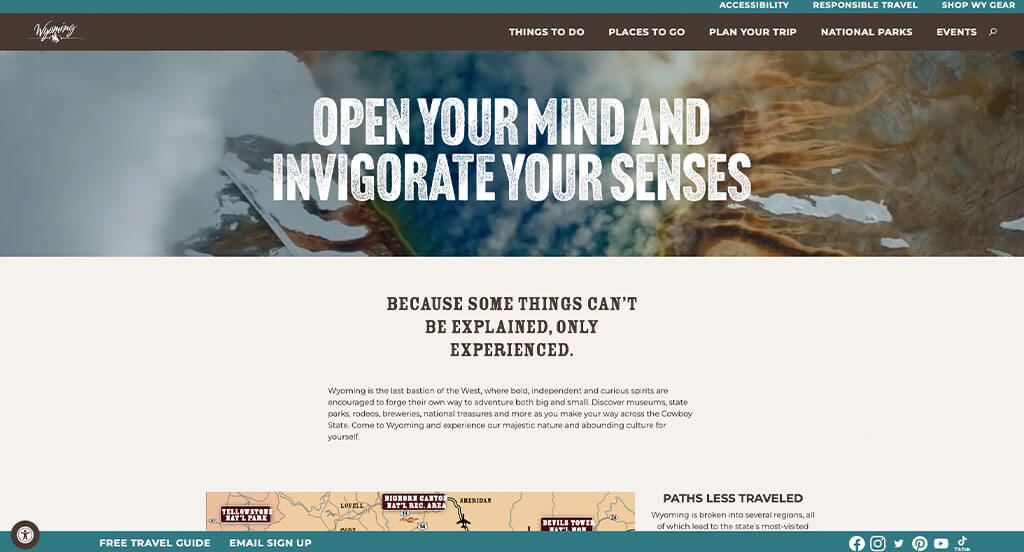
This is a great website example for travel destinations who are looking for a custom web design. After scrolling past the header of this tourist website, you’ll immediately notice the relaxed outdoor feel portrayed through their color scheme. Another thoughtful feature in this custom travel site we noticed was the creative fonts. From a marketing viewpoint, we really liked the way they utilized a well-labeled navigation bar. What a great website to review when designing your next website!
44. Visit Maine
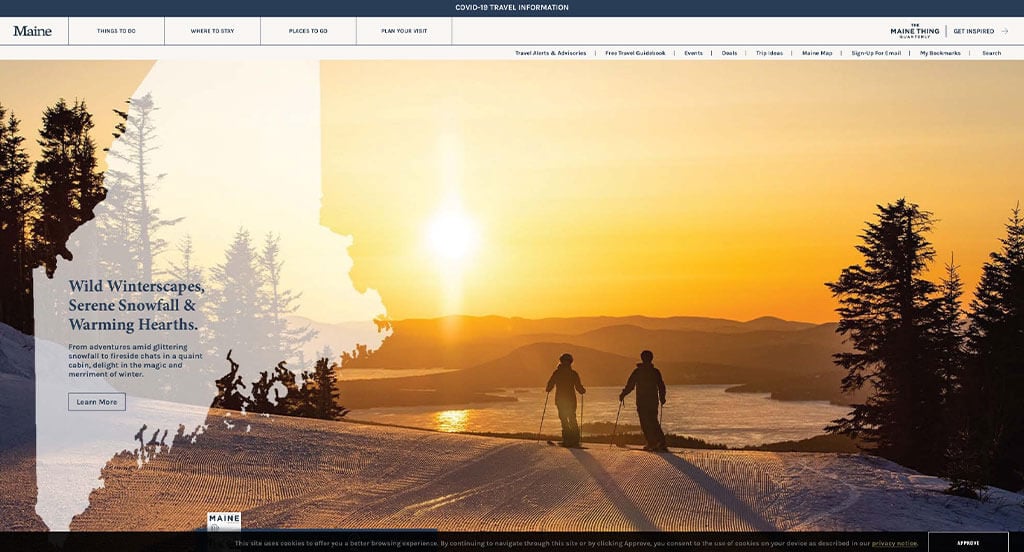
This is a good example of a web design for tourist destinations who are looking for a custom layout. As you scroll through the homepage, one of the qualities you’ll notice right away is the template that had a good balance of white space. The simple navigation throughout their site was definitely refreshing for a professional travel website. They clearly had conversations in mind when building the refreshing imagery for their website. Give some thought to the unique design of this tourism website when developing your next custom website.
45. Travel Alaska
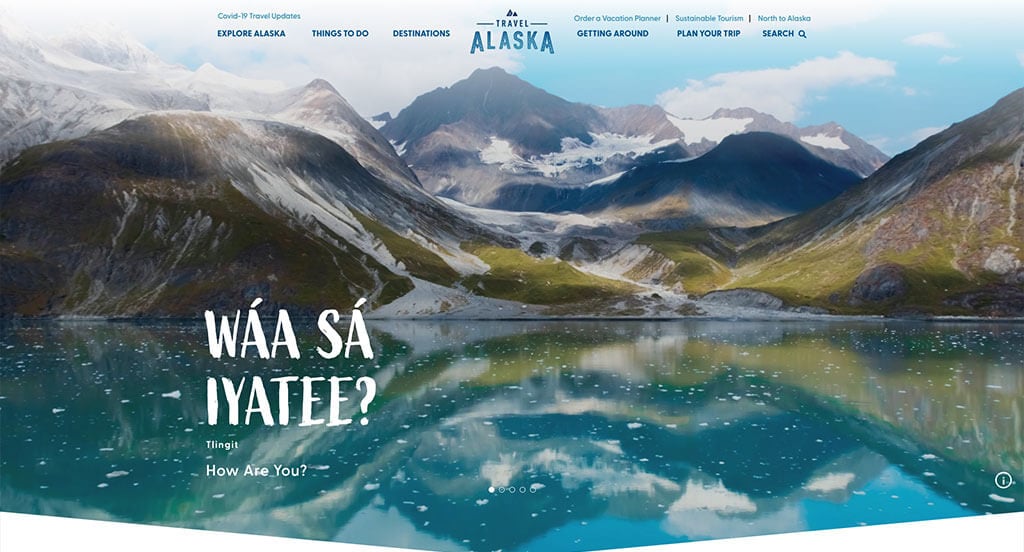
The mainly blue and white colors used in this custom travel website stood out to us because it matches their images. As you scroll through the homepage of this website, one of the design qualities you’ll notice is the layout and color scheme that feels authentic to their company. The unique fonts were another design quality in this custom travel destination website we enjoyed. They clearly had internet marketing in mind when building the stunning graphic bands for their website. If you are looking for template examples for your next tourism website, be sure to check this one out.
46. Explore Georgia
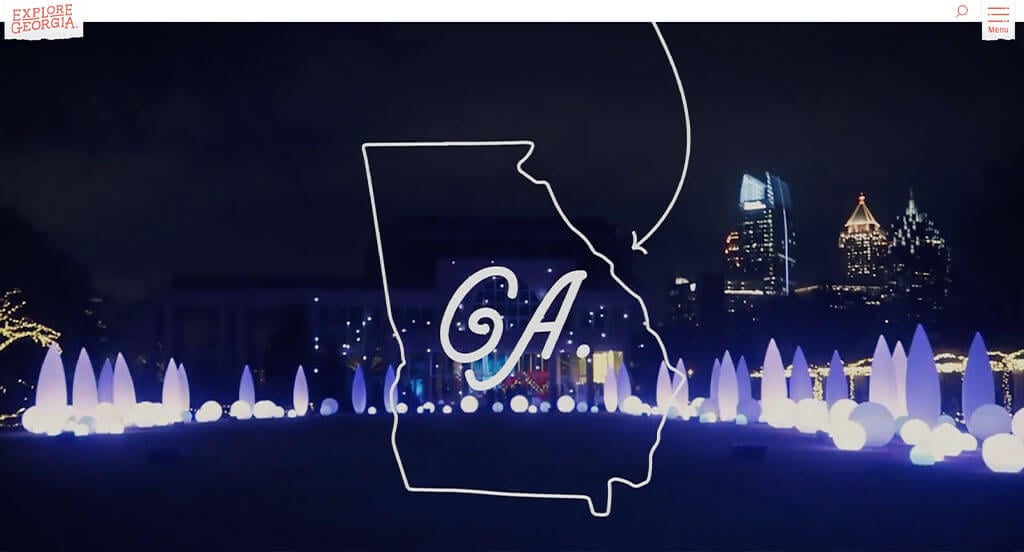
We immediately noticed the simple color scheme in the Explore Georgia website, which we liked because it allows the images and information to be the focus not the design. We thought this was a good homepage design example for tourist sites because of the subtle animations. The large imagery seen in this website helped it make it into our list of the best template ideas for travel destinations. Their clearly labeled menu helped make this one of the top tourism websites we considered. For the travel websites out there searching for website examples, make sure to check this one out!
47. Travel Kansas
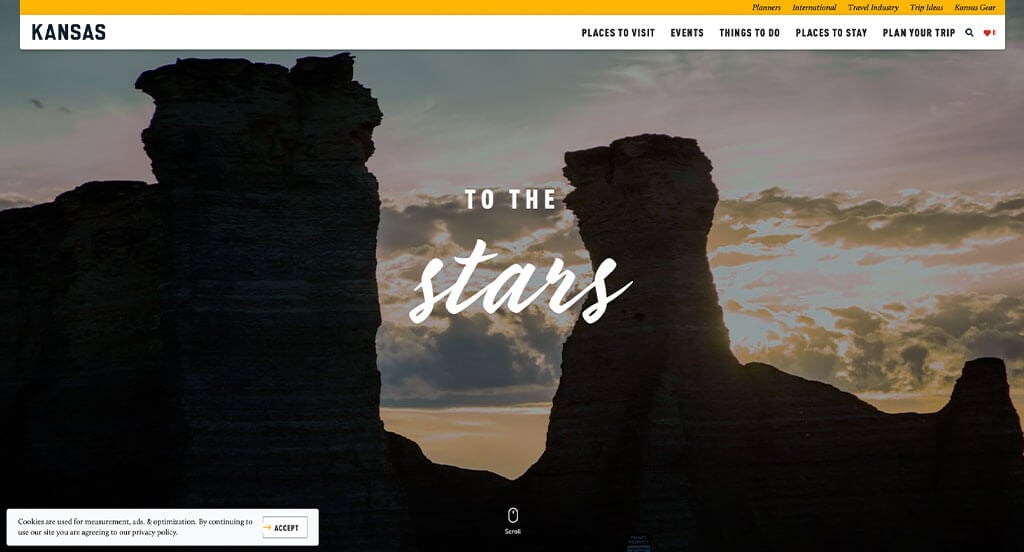
The yellow, white and black color palette used in this tourism website stood out to us because it creates a simple layout. After scrolling past the header of this tourist website, you’ll notice the smooth transitions. The use of short phrases was refreshing for a custom travel destination site. Travel Kansas had website marketing in mind when creating the ability to look at activities based on regions of the state. Any website designer making websites for tourist destinations will want to consider checking this website out.
48. Visit Virginia
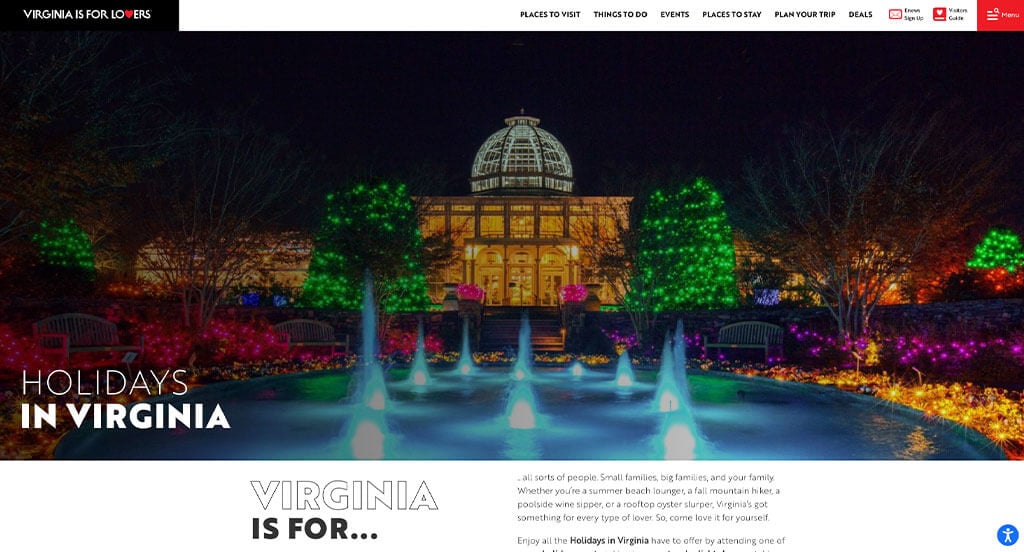
We liked how this tourism website combined the colors of black, white and red to create a custom web design. As you scroll through the homepage of this website, one of the qualities you’ll notice right away is their different thicknesses of fonts to show off titles. Another thoughtful feature in this custom tourist site was their addition of buttons for simple use. The videos displayed throughout their site was a marketing feature we noticed right away. Be sure to consider the unique design of this travel destination website when developing your next custom website.
49. Visit Maryland
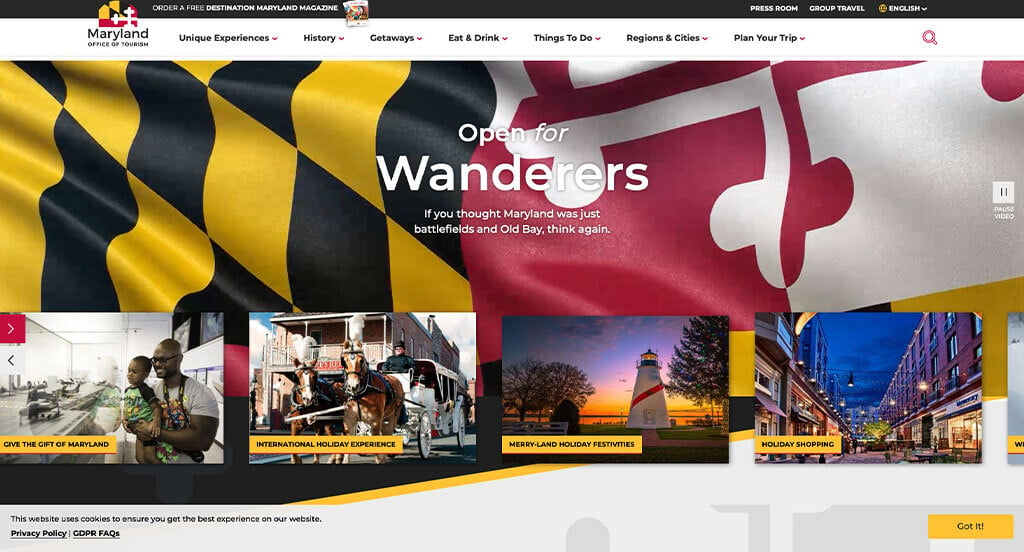
This is a creative website design example for tourism groups looking to build their next website. The animated waving flag was probably the most impactful quality in the homepage of Visit Maryland. Their trending section was definitely refreshing for a professional website. Visit Maryland had ease of use in mind when designing the domain for their website that matches their company’s name. What a great website to review when building out your next website!
50. Visit West Virginia
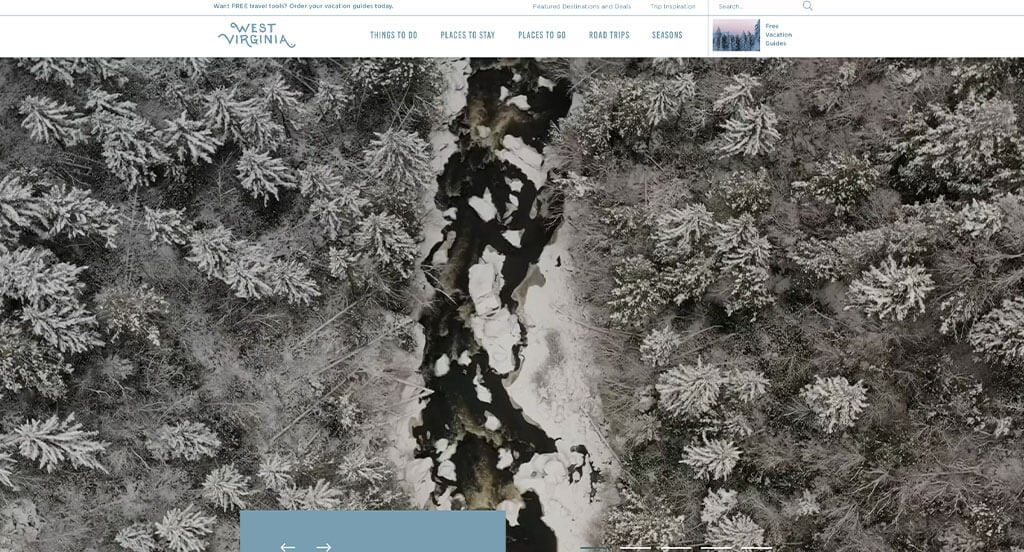
This is a good example of a website layout for travel destinations who are looking for inspiration for their next custom web design. We thought this was a good homepage design example for travel sites because of their stunning imagery. Their inclusion of social media was another reason why we included this website in our list of the best websites for tourist companies. Visit West Virginia clearly had a focus on ease of use when designing the well labeled navigation bar for their website. With so many good reasons to consider this tourism website, it’s no wonder we included it in this list of the best websites!
How to Build an Outstanding Tourism Website
Are you in the process of building a new website for your tourism company? How exciting!
Let’s walk through some of the most important steps in building a new, or redesigning an existing, tourism website.
Feel free to skip the first few sections if you already have a domain name, hosting service, and website platform picked out!
1.) Choosing a Domain Name
Selecting the right domain name for your tourism website is a critical step in establishing your online identity. It serves as the address that visitors will use to access your website and plays a significant role in branding and recognition.
Here’s a step-by-step process to help you choose the perfect domain name:
- Brainstorm: Start by generating ideas for your domain name, considering the name of your business, the tourist destinations you specialize in, and unique selling points.
- Simplicity: Strive for a simple and easy-to-spell domain name. Avoid complex words, hyphens, or numbers.
- Consistency: If your business has an established brand name, consider incorporating it into your domain name. For example, if your business name is Happy Travel Experts, avoid registering a domain like 123VacationPlanning.biz.
- Availability: Check the availability of your desired domain names early on. Many common domain names are already taken. If that’s the case, explore options for purchasing an available domain name. However, be mindful of the costs involved.
- Domain Extensions: Choose a domain name extension that aligns with your website’s purpose. While .com is widely recognized, consider other options like .net, .org, or industry-specific extensions like .travel.
- Legal Considerations: Before registering a domain name, conduct a trademark search to ensure it doesn’t infringe upon someone else’s intellectual property. Avoid using the name of well-known tourist attractions or other companies without permission.
- Register the Domain: Once you’ve identified an available domain name, register it through a reputable domain registrar. Based on our experience as a digital agency, we recommend using GoDaddy, or Namecheap for easy domain name registration.
2.) Selecting a Website Platform
After figuring out your domain name, the next step is selecting a website platform for your next tourist website.
Most tourist attractions are going to develop content-based websites with photo galleries, contact forms, live chats, and event calendars to drive conversions.
You’ll typically only see tourist websites adding ecommerce if they are selling souvenirs or tickets on their website.
For Content Websites:
Many tourism companies find WordPress to be an excellent platform. However, there are also options like Wix, and other hosted website builders that can meet your needs.
- WordPress: WordPress is a versatile and widely used content management system (CMS) that offers great flexibility and customization options. It caters to all types of tourism websites, from simple sites to more complex ones that offer online booking and reservation systems. With a vast collection of tourism-inspired themes and helpful plugins available, WordPress allows you to create a highly customized website tailored to your tourism hotspot or tourism company. It’s an ideal choice if you value control and want the ability to expand your website’s functionality over time. While there is a hosted version of WordPress, most users prefer the open-source version installed on a web hosting account.
- Wix: The Wix platform offers comparable page-building features. It is also a hosted solution. We have experience working on tourism websites built with Wix and found it to be a reliable page builder, making it another confident recommendation. With Wix, you won’t need a separate web hosting service.
For Ecommerce Websites:
If your tourism company sells products online, you’ll likely find either WooCommerce or Shopify suitable.
- WooCommerce: If you plan to build an online store for your tourism business using WordPress, WooCommerce is the ideal ecommerce plugin to install. It seamlessly integrates with WordPress, allowing you to add ecommerce functionality to your existing tourism website. WooCommerce offers a wide range of extensions, payment gateways, and inventory management tools, making it an excellent choice for tourism businesses looking to sell online.
- Shopify: The Shopify platform is a leading ecommerce solution that provides everything you need to create and manage an online tourism business. It is a hosted ecommerce platform, meaning you don’t need to find a separate web hosting service to use it. Like other ecommerce solutions, Shopify offers a user-friendly interface, customizable themes, built-in security, and a range of features for inventory management, payments, and shipping.
Web Hosting Requirements
If you choose a platform like WordPress or WooCommerce, you’ll need to find a web hosting service.
As a suggestion, we often recommend our own web hosting service for WordPress websites. For recommendations from other hosting companies, consider the following reliable options:
- WP Engine: This is one of our favorite web hosting services for tourism companies. WP Engine offers a great control panel that simplifies the creation of staging websites. Their backup process is also seamless. The only downside we’ve seen is the limits they place on PHP max_execution_time. Keep in mind that their pricing can increase quickly if you require upgraded services.
- SiteGround: We’ve always enjoyed working with SiteGround. Their live chat and email support is excellent compared to more well-known hosting firms. We’ve never had to wait long to get in touch with someone, and typically the first person we interacted with solved the issue. Their backup tools are also very user-friendly. They offer reasonable pricing for tourism companies.
- Digital Ocean: This is a great option for cloud hosting but may be too advanced for most tourism company websites. We’ve never had issues with the Digital Ocean cloud network, unlike other cloud networks we’ve tried. However, cloud hosting can be expensive when considering droplet (server instance) costs, operating system, control panel, server software, offsite backup, and server management fees. For server administration, you can check out AdminGeekZ for recommendations.
3.) Choosing a Website Template
Most tourism companies prefer to purchase and customize a third-party website template as it significantly reduces web development costs and turnaround time. However, if your company prefers a custom design, you can always hire a custom web developer or custom ecommerce developer to create a theme tailored specifically to your needs.
For setting up a tourism website, let’s focus on suggestions for finding a pre-built website template! Here are some links to the main theme marketplaces to consider:
WordPress Tourism Themes
You can find free themes at wordpress.org, or explore tourism-inspired templates on ThemeForest.
Roam – Themeforest
$89
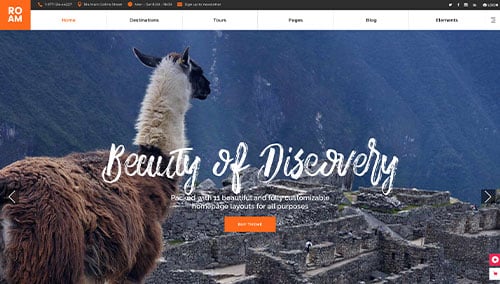
Getaway – Themeforest
$85
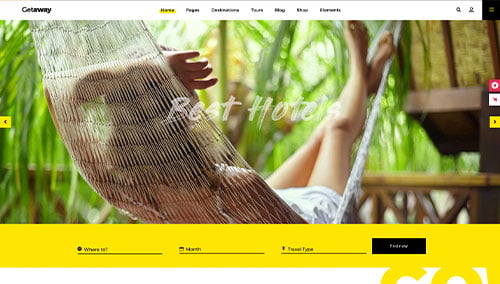
Kamperen – Themeforest
$85
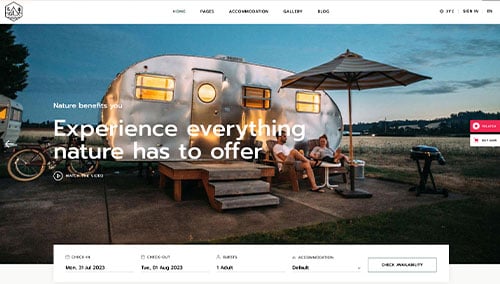
UniTravel – Themeforest
$69
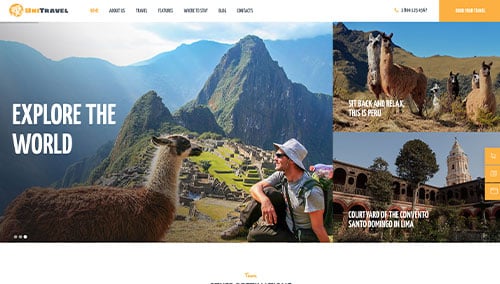
Wix Tourism Themes
You can find free and paid themes in their marketplace at wix.com, some of which are suitable for tourism companies.
4.) Crafting Content & Adding Visuals
Now that you have your domain name, website platform, and theme selected, it’s time to start building captivating content for your tourism website!
Here are some valuable tips to create engaging and effective website copy tailored to your target audience:
- Know your target audience: Before writing a single word, gain a clear understanding of your target audience’s demographics, preferences, and needs. Shape your content to address their pain points, provide value, and resonate with them. This will improve your search engine rankings for tourism-related searches relevant to your business.
- Define your key messages: Determine the main messages you want to convey through your website content. Align these messages with your brand, emphasize your unique advantages, and clearly communicate the benefits of your tourism services or attractions.
- Keep it concise and scannable: Online readers tend to scan content, so ensure your writing is concise and easy to digest. Use short paragraphs, bullet points, subheadings, and bold text to break up the content and enhance readability.
- Create clear and compelling headlines: Craft attention-grabbing headlines that instantly communicate the value and relevance of your tourism business. A well-crafted headline can entice visitors to explore your website further and learn more about what you offer.
- Strategically incorporate keywords: Conduct research on relevant keywords and naturally incorporate them throughout your content. This can boost your tourism website’s visibility in search engine results. However, avoid keyword stuffing, as it can negatively impact readability and user experience. Tools like Ahrefs or Semrush can assist with keyword research.
- Maintain a conversational tone: Write in a conversational style that resonates with your tourism audience. Avoid jargon or overly technical language unless your target audience specifically requires it. Engage your readers by addressing them directly and adopting a friendly, approachable tone.
- Edit and proofread: Always edit and proofread your content before publishing. Check for grammar, spelling, and punctuation errors. Ensure the flow of your content is smooth and logical, aligning with your brand voice and style guidelines. Tools like Grammarly can be helpful in this regard!
- Leverage ChatGPT for assistance: If you encounter challenges generating ideas or need help refining the content on your tourism website, consider leveraging AI tools like ChatGPT.
Break up lengthy text sections by incorporating relevant and high-quality images into your content. Consider the following tips:
- Choose high-quality images: Opt for visually appealing and well-composed high-resolution images. Blurry or pixelated images can diminish the overall quality of your tourism website.
- Ensure relevance: Select images that are directly relevant to your content and effectively illustrate your message. Images should complement the text and provide additional context or visual interest to enhance the visitor’s experience.
- Explore stock photo resources: Utilize reputable stock photo websites such as Unsplash, Pixabay, or Shutterstock to discover a wide range of professional-quality images related to tourism that align with your website’s theme. Be mindful of licensing requirements and attribute images when necessary.
- Customize images when possible: If you have the skills or resources, consider customizing or branding images to maintain consistency with your tourism brand. This can create a unified visual experience for your visitors. Tools like Adobe Photoshop or Canva can be useful for this purpose.
- Optimize image file sizes: Compress images to optimize their file sizes without compromising quality. Large image files can slow down your tourism website’s page speed, negatively impacting user experience and SEO. Tools like TinyPNG can assist with this task.
5.) Post Launch Strategies
Once you have built and launched your tourism website, there are several essential tasks and services to consider for maximizing its effectiveness. Here are some fundamental suggestions to help you navigate post-launch activities:
- Search Engine Optimization (SEO): Boost your tourism company’s visibility in local search results by implementing SEO strategies. Conduct keyword research, optimize your content, and ensure a solid internal linking structure. Regularly update your website with fresh, high-quality content to attract organic traffic. Consider hiring our SEO team or explore third-party providers like The HOTH for assistance.
- Paid Advertising: Drive targeted traffic to your tourism business by utilizing paid advertising platforms such as Google Ads or Facebook Ads. Consider hiring our PPC management services or sourcing talented professionals from websites like Mayple for quicker results.
- Conversion Rate Optimization (CRO): Analyze your tourism website’s performance and user behavior using tools like Google Analytics. Identify areas where users may drop off or face barriers to conversion. Conduct A/B testing with tools like VWO to make data-driven changes that improve conversion rates and enhance the overall user experience of your tourism website.
- Website Security: Protect your tourism website from malware and other threats. Implement robust security measures such as SSL certificates, web application firewalls (e.g., Sucuri), and regular backups. Keep your CMS, plugins, and themes up to date to minimize vulnerabilities. Monitor your website for potential security risks and promptly address any issues. Consider utilizing a website uptime monitoring service like UptimeRobot.
- Website Maintenance: Ensure optimal performance of your tourism website by regularly maintaining it. If you’re using WordPress, this includes updating plugins and themes, monitoring website speed and performance, and resolving broken links or errors. Consider hiring our website maintenance services or finding freelancers on platforms like Upwork. Don’t forget to regularly back up your tourism website to protect against data loss or technical issues.
- User Feedback and Testing: Actively seek user feedback to understand visitor experiences and identify areas for improvement. Implement user testing to gain insights into how users interact with your tourism website. Use this feedback to make iterative enhancements and continuously optimize the user experience.
- Content Updates: Keep your website content fresh and up to date. Regularly publish new blog posts about tourist hotspots, update product or service information, and ensure all information is accurate and relevant. Engaging and valuable content not only attracts visitors but also encourages them to return and share your content with others interested in tourism.
Remember, post-launch digital marketing activities are crucial for the long-term success of your tourism website. Stay proactive, monitor performance, and adapt your strategies to achieve your business goals and meet the needs of your audience.

